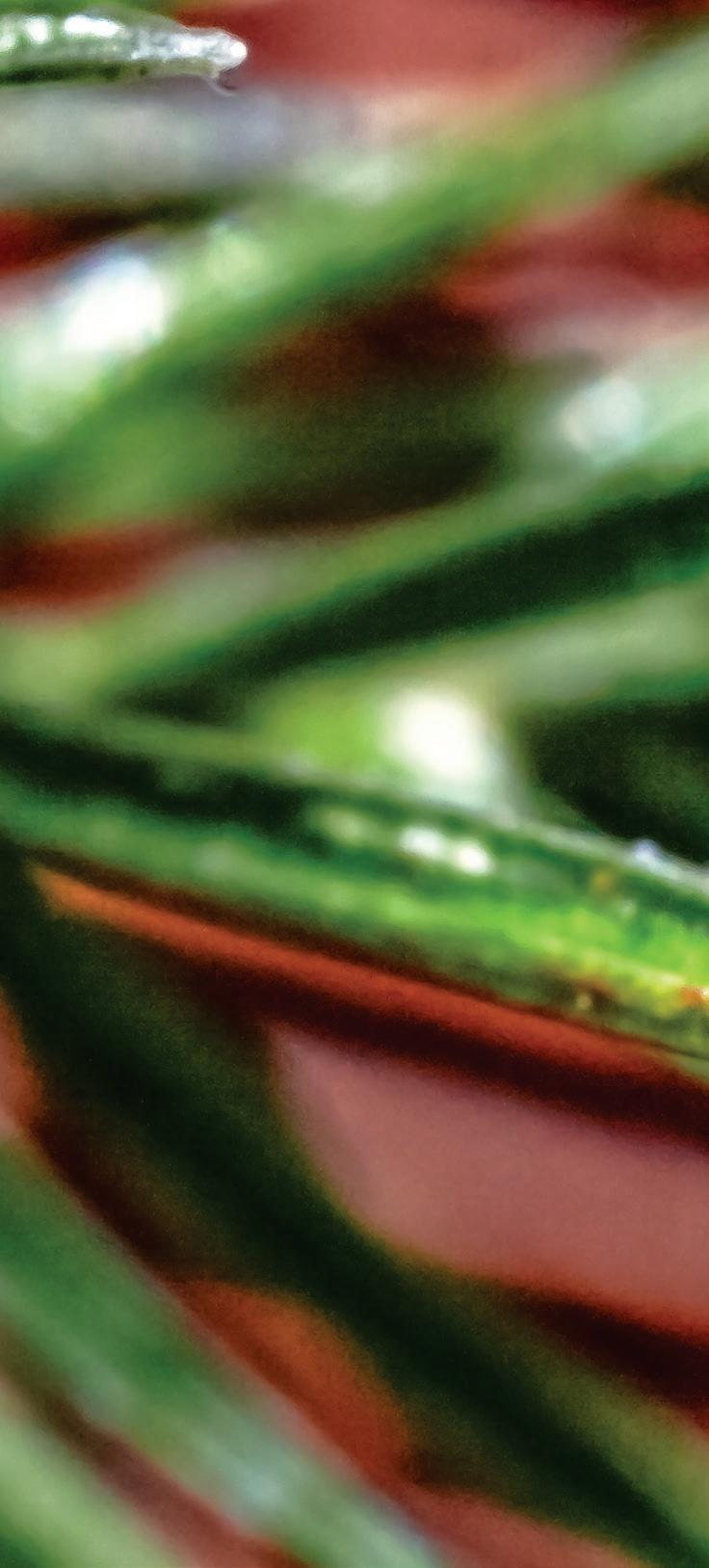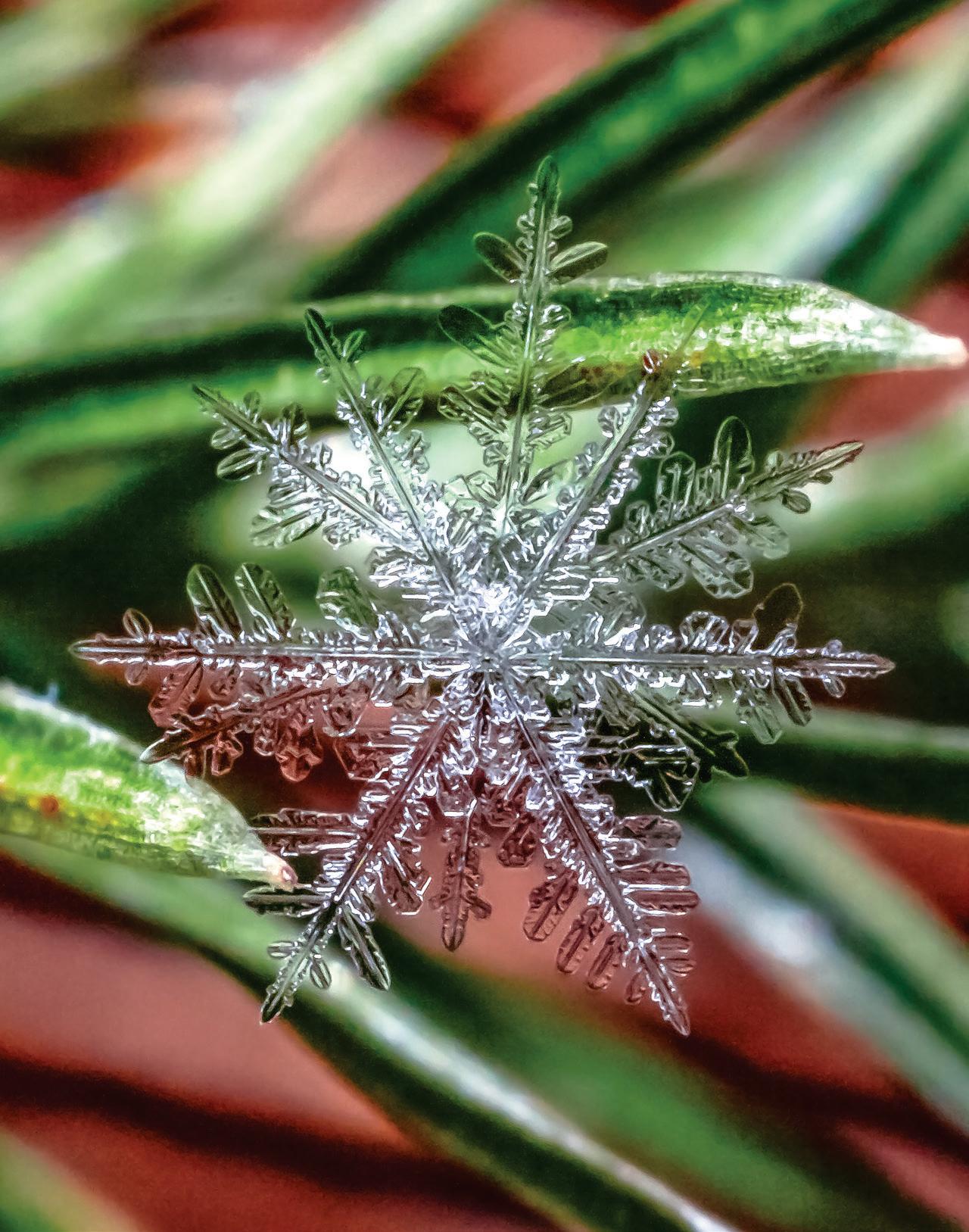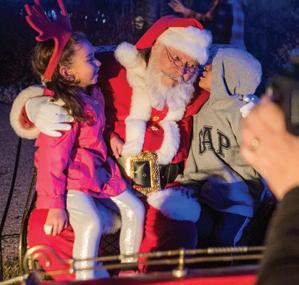






















ISSUE NO. 64 NOVEMBER/DECEMBER 2022
22 Snowmobiles on Wolf Creek Pass
Backcountry snowmobile guides Forest and Jaclyn Bramwell of Pagosa Springs brave wintry terrain to lead guests through forests filled with pristine seasonal splendor.
Story and photographs by Joshua Hardin
30 Ice and Steam in Ouray
Steam rises from the hot springs pool on one side of town, while on the other, climbers use ropes and axes to scale sheer walls of blue ice in Ouray, home of history, adventure – and an unforgettable bipedal dog named Dexter.
By Matt Masich
46 Wildlife Pilots
Colorado Parks and Wildlife has a team of pilots who fly missions across the state to stock alpine lakes with fish and help biologists determine how many wild animals live in Colorado and what their migration patterns are.
By Caroline Araiza
52 Behind the Scenes at Breck
We meet members of the small army of employees whose dedicated work keeps Breckenridge Ski Resort running, from lift maintenance, to snowmaking, to snowcat operators.
Story by Matt Masich
Photographs by Joe Kusumoto
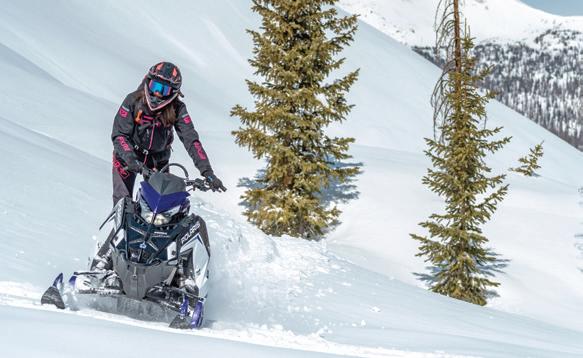
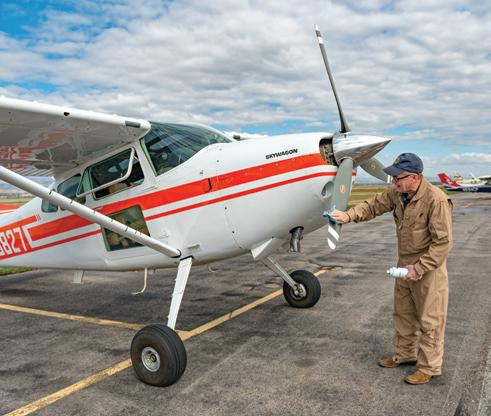


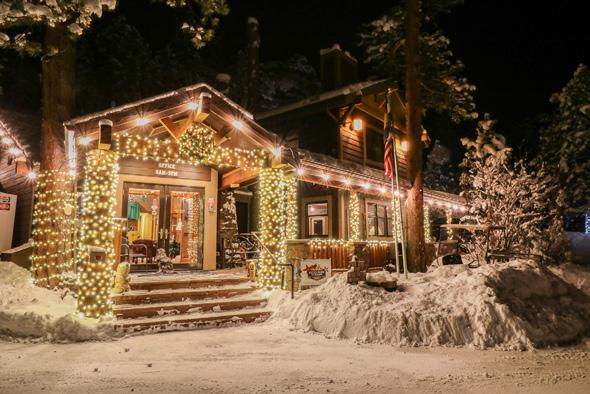

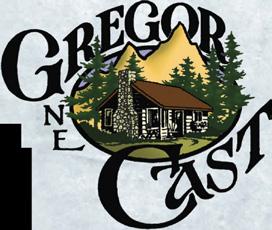



A climber scales rock and ice to compete at the Ouray Ice Festival at Ouray Ice Park. Story begins on page 30.
PHOTOGRAPH BY GUY SCHMICKLE
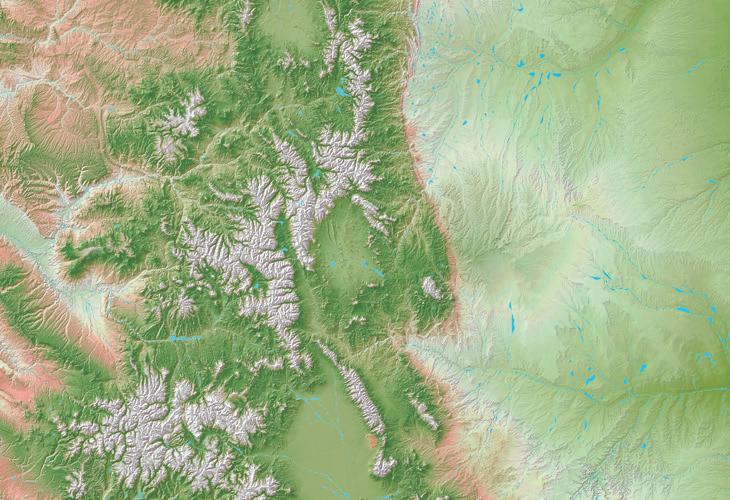
Walden, p 12
Grand Lake, p 70
Meeker, p 61
Fruita, p 67
Grand Junction, p 46
Montrose, p 46
Ouray, p 30
Red Feather Lakes, p 15
Severance, p 17
Loveland, p 46
Boulder, p 13
Breckenridge, p 52
Cripple Creek , p 60
Victor, p 60
Denver, p 62
Boulder quilt artist captures pets’ personalities, Severance couple raises bees to make mead, gnomes populate Red Feather Lakes road and Colorado Life gets a sister magazine.
Test
Pagosa Springs, p 22
43 Poetry
Colorado Springs, p 46
In our editors’ choice photo, an incredible shot of a single snowflake at Grand Lake reveals a hidden world of beauty. ON THE COVER
Sweeten the season with these holiday candy recipes.
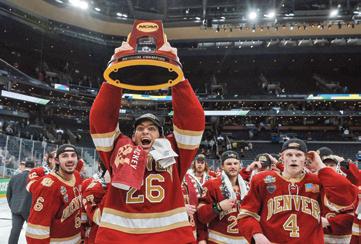
As families come together for the holidays, our poets share their reflections on treasured Colorado memories.
60 Go. See. Do.
A statewide roundup of the best local festivals, events and daytrip ideas gives a plethora of opportunities for fun wintertime adventures in all parts of the state.
67 Colorado Camping
High-clearance roads lead to canyon country campgrounds at the far edge of the Western Slope in Rabbit Valley.
70 Top Take

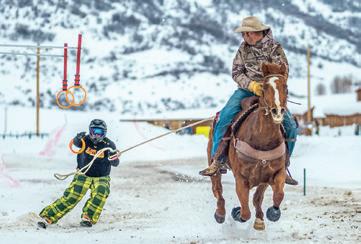


Volume 11, Number 6
Publisher & Executive Editor
Chris Amundson
Associate Publisher Angela Amundson
Editor Matt Masich
Photo Editor Joshua Hardin
Design Madison Dupree, Open Look Creative Team
Advertising Sales
Marilyn Koponen
Subscriptions
Lea Kayton, Katie Evans, Janice Sudbeck
Colorado Life Magazine PO Box 270130 Fort Collins, CO 80527 970-480-0148 ColoradoLifeMag.com
SUBSCRIBE
Subscriptions are 1-yr (6 issues) for $25 or 2-yrs (12 issues) for $44. Please call, visit ColoradoLifeMag.com or return a subscription card from this issue. For fundraising and corporate rates, call or email subscriptions@coloradolifemag.com.
ADVERTISE
Advertising deadlines are three months prior to publication dates. For rates and position availability, please call or email advertising@coloradolifemag.com.
CONTRIBUTE
Send us your letters, stories, photos and story tips by writing to us, visiting ColoradoLifeMag.com or emailing editor@coloradolifemag.com.
COPYRIGHT
All text, photography and artwork are copyright 2022 by Flagship Publishing Inc. For reprint permission, please call or email publisher@coloradolifemag.com.

PHOTO EDITOR JOSH HARDIN and I joined Colorado Life together as inaugural staff members when the magazine launched 10 years ago. In the decade since, we’ve each traveled across Colorado getting into all sorts of adventures while working on stories.
The thing is, Josh’s adventures have always been a bit more … adventurous. For instance, when I wrote a story on Colorado Gators Reptile Park in Mosca, I talked with owner Jay Young about gator wrestling, but I didn’t actually go inside the gator pen – I left that hazardous duty to Josh, who bravely risked life and limb to photograph the savage swamp beasts. While on assignment, Josh has sailed in a chase boat in the Dillon Open Regatta, flown in a glider along the Front Range near Wellington, and even flown in a helicopter while working on a story about the Unaweep-Tabeguache Scenic and Historic Byway on the Western Slope. And me? Well, I once rode the miniature steam train at kiddie destination Tiny Town in Morrison.
So when it came to assigning this issue’s page 22 feature on riding snowmobiles in the San Juan Mountains near Pagosa Springs, there was no question this would be a Josh story. This was Josh’s first time riding a snowmobile, and he admitted to being a bit nervous when Forest and Jaclyn Bramwell, owners of SnowCountry Snowmobile Tours, instructed him to hop on one of the machines when he met them at the top of Wolf Creek Pass.
The Bramwells gave him a tutorial, then set off through the snowy wilderness. Before they departed, they told him to steer clear of trees, as first-timers have a remarkable knack for crashing into them. Sure enough, not 30 minutes had gone by before Josh crashed into a tree. He was unhurt – he bailed from his snowmobile a split second before the collision. Fortunately, the snowmobile was also unhurt.
The rest of Josh’s excursion was crash-free. At the end, he was amazed to have done something he never imagined he would do – and thankful to have had kind and patient guides like the Bramwells to show him the ropes.
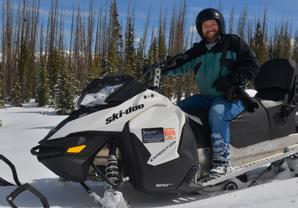
Outdoor adventure is near and dear to many Coloradans’ hearts. Much of that adventuring would not be possible without guides and instructors to help people on their way. When I was in Ouray working on this issue’s story on the town, often considered the epicenter of outdoor adventure in Colorado, I met Logan Tyler, owner of guiding company Basecamp Ouray. As he leads clients up on ice climbing expeditions or on the via ferrata he built, guiding is almost a philosophical pursuit.
“People come to us because they have an internal story they want to change, and it’s our job as guides to find out what that story is and help them get there,” Logan said. “Through discomfort, through the unknown, through leaning into fear come these existential epiphanies.”
For this issue’s story “Behind the Scenes at Breck,” I interviewed some of the hundreds of people who work every day at Breckenridge Ski Resort to make it possible for skiers and snowboarders to enjoy the mountain. Among them was Nina Michel, training manager of Breck’s Ski and Snowboard School.
“The first thing people have to know is that anyone and everyone can ski or snowboard,” Nina said. “What we need to do is find the way to help them find the fun and joy in it.”
In our small way, I hope Colorado Life can likewise help our readers find the fun and joy in exploring Colorado.

Matt Masich Editor editor@coloradolifemag.com
A gem near Cannibal Plateau
I enjoyed your article “The Devil Went Out to Colorado” in the September/October 2022 issue of Colorado Life. I want to add another devilish place to your list. A few years ago, I went on a backpacking trip in the Powderhorn Wilderness here in Colorado, starting at Deer Lakes near Slumgullion Pass, which is close to Lake City and the famously hellish Slumgullion Earth Flow.
My destination was a high alpine lake at about 12,000 feet elevation, named Devils Lake. This seldom visited jewel is nestled between two huge plateaus, one of which has an interesting unhallowed name of Cannibal Plateau. The other one is the Calf Creek Plateau.
These two neighboring plateaus, which are over 12,000 feet elevation, make up the largest relatively flat expanse of alpine tundra in the lower 48 states. These plateaus were created by tertiary volcanic deposits that are believed to be 5,000 feet thick in some places. I’ll leave it up to your readers to guess at who the Cannibal Plateau might be named for ... hint: Think diabolical and the initials A.P.!
Tom Helm Durango
Bedeviled yet again
I would like to start with how much we enjoy Colorado Life. The photography is wonderful, and the articles make us dream of new places to see and tempt us to plan more trips.
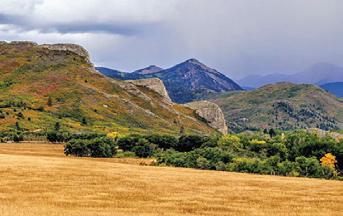
“The Devil Went Out to Colorado” in the September/October 2022 issue reminded us of The Devil’s Staircase,” south of La Veta along Highway 12. In town, we were told the legend of this beautiful rock formation. God invited the devil to climb
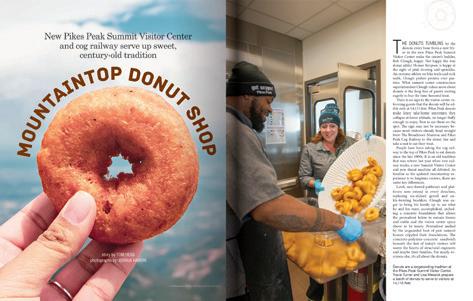
out of hell to view all he was missing. The devil used these mountain steps to reach the vantage point and see all the beauty and color of Colorado. Alas, he had to use them to go back down, too!
One more spot to shed light on the beauty of our state that your magazine brings to the mailbox six times a year.
Jim and Gloria Wright Arvada
Apples truly do abound
I always enjoy the magazine and read it cover to cover. I do have a question about the Cedaredge apple article (“Apples Abound in Cedaredge,” September/October 2022). It says Williams Orchards grows as much as 5,000 trees per acre across 800 acres with some 1.7 million trees under their care. An acre is 43,560 square feet, and it seems 5,000 trees would be awfully crowded. I am really curious about these figures.
Joan Fields Brighton
Editor’s reply: Those figures are accurate. Williams Orchards uses high-density growing techniques at many of its orchard locations. They use both spindle and super-spindle growing methods – spindle is anything under 1,200 trees per acre, while super-spindle is anything over that. The trees are planted and wires are run through the system, much like growing grapes.

Cedaredge makes the cover
I was thrilled to see the cover of the September/October 2022 issue of Colorado Life and wanted to reach out and thank you. As one of many people along the Front Range who split their time between the Front Range and the Western Slope, I have come to love the Western Slope and the opportunities that abound there. Some time ago, I reached out to you with an idea for a story about Cedaredge’s Applefest, so when I saw the beautiful cover and story, I wanted to thank you. We hope you and your staff can make it to Applefest this year and enjoy the fantastic music all weekend long – along with the apples!
Tonie Selig Miller Colorado Springs
When we lived in Grand Junction on 29 1/2 road, meaning it was that many miles to Utah, we could see the Grand Mesa from our house. In winter, there was a shape of a snow goose in the snow on the Mesa. Our neighbors told us not to plant a garden until the goose’s neck was broken when the snow started to melt. We followed their advice and had successful gardening. It helped the soil when Mount St. Helens blew up and we had ash from that on our cars and in the garden. I always enjoy your articles, and especially the poetry – I read that first.
Charlotte Faris Aurora
Love for southern Colorado
I enjoyed reading the September/October 2022 issue of Colorado Life. I was very disappointed that you didn’t include the southern third of the state, with the exception of Durango.
Pueblo has a wonderful Chile and Frijoles Festival every September, and it was not even mentioned. The Colorado State Fair in August is an important statewide agricultural event, held in Pueblo. Again, no mention. Rocky Ford watermelon and cantaloupe are huge agricultural crops and could use your magazine’s acknowledgement. Please include the southern third of the state in your articles.
Julie Porter Pueblo West
Editor’s reply: We will keep trying our best to bring you stories from all parts of Colorado. We have written about all the things you mentioned in previous issues, and we will very likely cover them in the future.
Morgan County says hello
Just finished reading the September/October 2022 issue. Always a great read. I really appreciate the Colorado Trivia. Even though I am a Colorado native, I always learn something.
I would like to invite you to visit Morgan County. Lots to see in our neck of the woods. The Rainbow Bridge welcomes folks with the 11 90-foot rainbow arches that cover the South Platte River. The two nationally acclaimed disc golf courses, Optimist Park and Pessimist Park, are close by. Fort Morgan is in the middle of quite a transformation. HGTV Hometown Takeover has selected Fort Morgan as season 2, which will be aired next spring. They have been in town for about 60 days and are renovating six community spaces, six
businesses and six homes. We are already seeing two murals and a new sign on the Rainbow Bridge.
We own the only vineyard and winery in Morgan County, Country Roads Vines and Wines, and serve as a Harvest Host for campers and RVers. We started the winery in 2018, became licensed in fall 2019, survived 2020, opened the tasting room in July 2021 and host live music throughout the summer and fall.
Other notable events in the county include BobStock, a free music festival in June, Pope Farms Corn Maze and fall activities in October and a car show in September.
Sharon
K. Kauffman Fort Morgan

Lions, tigers and bears
I have to commend you on your wonderful story on the Wild Animal Sanctuary in the September/October 2022 issue. I’d heard of the Wild Animal Sanctuary but didn’t know much about it. I can’t believe there is a person out there who shelters these lovely animals and takes care of them out of the goodness of his own heart. I am so glad that someone is helping these abused animals and is giving them a new and wonderful place to heal and get well again. We are planning a special trip to Keenesburg Overset text 17 words
Our July/August “Colorado Camping” column was about the May Queen Campground at Turquoise Lake near Leadville, but the pinpoint on the accompanying map was mistakenly placed at Cortez.
We can’t wait to receive more correspondence from our readers! Send us your letters and emails by Dec. 1 to be published in the January/February 2023 issue. One lucky reader selected at random will receive a free 1-year subscription renewal. This issue’s winners are Jim and Gloria Wright of Arvada. Email us at editor@coloradolifemag.com or write by mail to PO Box 270130, Fort Collins, CO 80527. Thanks for reading and subscribing!


Near Walden, a male sage grouse’s plumage is on full display as it performs a ritual mating dance to attract the attention of nearby females. This image won the Colorado Nature special award at the Share the View International Photography Competition.
by JOSHUA HARDIN
ASAGE GROUSE STRUTS his stuff in a flurry of feathers at a North Park lek near Walden.
Photographer Karen Fiant knows the Jackson County location well from visiting multiple times a year. However, one cloudy, snowy day was unlike the rest when she overslept and arrived at the grouse lek after sunrise. She was driving last in a line of cars visiting the lek’s far side when she spotted one bird across the road displaying a ritual mating dance for the attention of nearby females.
Photographing from her vehicle to keep the birds from being spooked allowed Fiant to try a variety of different angles, leading to a bright, behind-the-back profile of the grouse’s plumage and face.
“I took a gazillion pictures of him displaying,” Fiant said, but one perspective of
the grouse’s vigorous movements caught the attention of judges for the Share the View International Photography Competition and won the Colorado Nature special award sponsored by Colorado Life Magazine.
Based in Denver, Fiant’s interest in wildlife imagery sparked after she took junior college photography classes and attended workshops given by photographers Wendy Shattil and Bob Rozinski, including one at Great Sand Dunes National Park and Preserve. Fiant encourages people to find mentors to learn what makes photos good. Learning how light affects subjects, focusing for sharp eyes, recognizing the behavior patterns of species and a love of the environment are honed from practice and advice from fellow photographers.
“What I enjoy about this is it gets me outdoors,” she said. “It gives me a sense of
purpose to learn about my subjects and be a supporter for conservation.”
Share the View aims to increase appreciation of the natural world by highlighting images from outstanding photographers. The 2022 contest is open now until Dec. 1 to all photographers, 18 years and up. A total of $5,000 in prizes is available. Photographers may enter any number of photos at $10 per image or six images for $50. Images may have been created with any kind of camera but must be uploaded digitally. For more information and to enter the contest, visit sharetheview.contestvenue.com.
This photo was taken with a Canon EOS R5 camera, exposed at 1/1600 a second at f/7.1, ISO 1250 with a Canon EF 500mm f/4 lens and 1.4x teleconverter.

by KAILEY PICKERING
Barbara Yates Beasley grew up in Sugarloaf, outside Boulder, surrounded by dogs, chickens, goats and a lamb. In her entire life, she has only gone nine days without a dog by her side. Her current border collie-cattle dog-sheltieshepherd-chow mix, Roxy, not only finds herself in the branches of Beasley’s maple tree, but also in Beasley’s vibrant, quilted portraits.
Beasley pours her love for animals into her passion for quilt art as she crafts lasting portraits of beloved pets that owners can keep forever.
She spends hours studying photographs of animals, tracing their outlines digitally, detailing the image with the right colors and transferring the product to fabric, where she completes the portrait. The final portrait appears as quilted fabric mounted on a frame that is easily hung on a wall like a picture. Her work vividly captures the animal subjects’ personalities – or even their souls.
Many customers place orders for pets who have died. “It’s not unusual for me to have the Kleenex handy,” Beasley said.
A recent customer ordered a portrait for his friend, whose pit bull mix had recently died. The customer sent Beasley
an abundance of pictures of the dog. In each picture the dog’s coat was a different shade, slowly turning from brown to white as he aged. After consulting her client, they decided to recreate a picture of the dog wearing a baseball jersey, but Beasley would make the fur the darker color from earlier pictures. After seeing the completed portrait, the customer was so touched by the way she brought the dog back to life that he hugged her in thanks.
Beasley also enjoys depicting wild animals in her quilting. Some favorites are tigers, a shoebill stork, gorillas and lions, which she crafts into quilts that hang in

her studio. She once constructed a portrait of a green-winged macaw. A friend bought the portrait and brought it home where her male green-winged macaw began flirting with the portrait. “I was just stunned that the bird was so fascinated by my work,” Beasley said. “I mean, it’s one thing to have the humans love it, but to have this bird really like the work, too – it was cool.”
Beasley’s work is always on display at Lyons Quilting in Lyons, where people are welcome to visit her studio upstairs if she is available. Her work has also been featured at the CSU Veterinary Hospital in Fort Collins, Rocky Mountain Quilt Museum in Golden and Face of Fiber in the Rockies in Estes Park.
Through her work in Colorado, Beasley has felt how much pet owners love their pets. “They would do anything for them,” Beasley said. Her work helps people remember their pets forever.






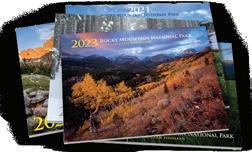

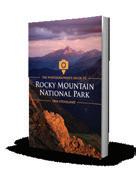

by SARA BRUSKIN
Once upon a time, a gnome and an elf met in an enchanted forest.
They became fast friends and decided that the forest was a lovely place to make a home. Calling on all their family and friends to relocate, they soon amassed a large community in Red Feather Lakes. Over the years, other creatures like fairies, leprechauns and dinosaurs joined them, along with Wonder Woman and Colorado Rockies players Wilin Rosario and Troy Tulowitzki.
While it may sound like a fever dream – or perhaps the product of an overactive imagination fueled by Colorado’s boom-
ing cannabis industry – this place actually exists. Granted, the mythical woodland creatures are mostly lawn ornaments, Wonder Woman is an action figure and the Rockies players are bobbleheads, but it’s still pretty magical.
Elf Lane, also known as Gnome Road, is a short stretch of dirt road that locals and tourists have bedecked with individual figurines and whole tableaus of tchotchkes. Some of the “residents” stand out in bright colors and obvious places, while others are more subtle, some hiding in trees or behind boulders.
Red Feather Lakes, the tiny town that hosts this fairytale byway, is an hour northwest of Fort Collins and is mostly

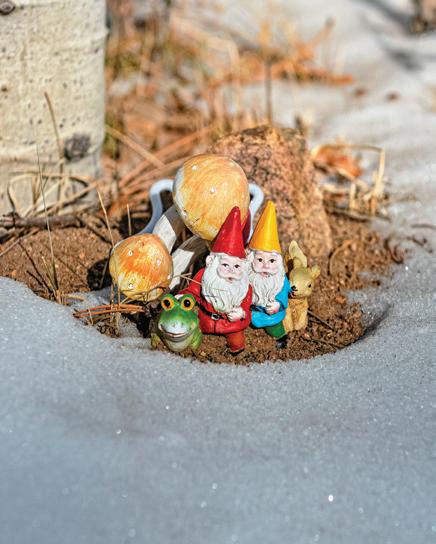

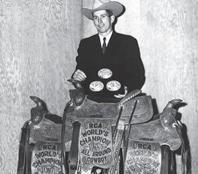
An assortment of gnomes, elves and other kitschy figurines populates a forest road in

known for its fishing and scenery. The nearby Drala Mountain Center, previously known as the Shambhala Mountain Center, draws some additional visitors, but the area isn’t what one would call crowded or touristy.
The town’s collection of fantastical knickknacks started off small, with a few locals who added items periodically. As word about Elf Lane spread, visitors also began bringing their own additions to the neighborhood. Wilderness-loving Coloradans are usually vehement about adhering to “leave no trace” principles, but Elf Lane doesn’t seem to attract criticism. Maybe the Forest Service makes exceptions for whimsy.
Elf Lane can be found along Illy Road, a 0.2-mile stretch between Hiawatha Lake and Apache Lake. Visitors are asked to follow the instructions painted on a sign: “PLEASE do not take us, break us or relocate us, as we live here on Elf Lane to

watch over children and all the little animals.”
To keep up with the pint-sized community, visit the Facebook group “Red Feather Lakes Elf Lane.”
Bird watchers are finding their perfect playground on the Pioneering Plains of northeast Colorado. The natural backdrop of Plains areas in Sterling and Logan County invites birders to journey off the beaten track in search of new encounters with a variety of species in an unspoiled environment.
Did you know there are more than 300 species of birds in this
A pair of social media-savvy gnomes pose for a selfie on Elf Lane. The whimsical road in Red Feather Lakes started with just a small handful of knickknacks that people gradually added to.

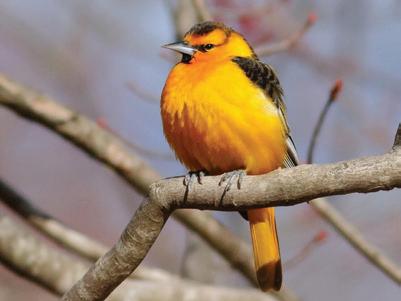
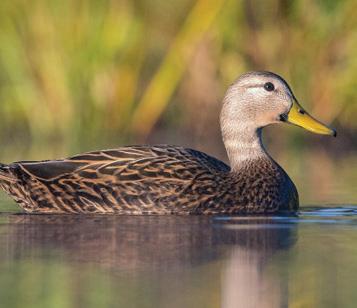

by KAILEY PICKERING
When Greg and Kim Bowdish of Severance tell people they’re the owners of Hunters Moon Meadery, they’re often met with looks of confusion. People will ask, “What is a meatery?”
No, not a meatery, they explain – a meadery, a place that makes the honey wine known as mead. The Bowdishes sell their mead at wine festivals, where they give people a crash course on mead’s rich legacy.
In ancient times mead was the “nectar of the gods,” Greg said. “This is what the royalty drank, while the serfs drank beer and grape wine.”
Mead uses honey as a base instead of the barley or grapes used to make beer and wine. The fermented honey drink has been around for 9,000 years, but for centuries it was only consumed by the very wealthy because honey was expensive.
In the couple’s backyard in Severance, 10 wooden beehives buzz with working bees zooming in and out of the wooden structures. A few yards away lies a straw bale building that houses Hunters Moon Meadery. Inside the building await the 50-gallon tanks and other equipment Greg and Kim Bowdish use to craft their mead.
Their mead journey began in 2001, when Greg’s co-worker asked if he could
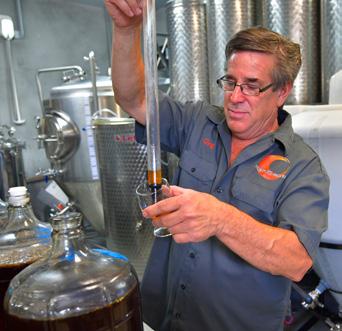
keep bees on the Bowdishes’ land. When they agreed, Greg and his co-worker took a beekeeping class and began caring for the hives that continue to buzz in his backyard.
The bees extract nectar from area plants like alfalfa, Russian sage and salvia, creating a locally flavored honey. As the bees are hard at work, it’s important not to disrupt them, so Greg will check on the bees a few times over the summer to make sure they are working. He also treats the hives twice a year for varroa mites, which trouble bees in the area. In a good year, the bees will produce up to 60 gallons of honey per hive, creating an abundance of honey for mead.
Greg started by homebrewing mead, taking the time to learn the right technique to make a quality product. Greg and Kim began creating a variety of flavors as they opened their meadery in 2010. They use plants grown right on their property, like chokecherries, chamomile, peppers and apples to flavor their meads.
One creation that has become a Hunters Moon favorite is Earl Greg, named after Greg and encapsulating the taste of Earl Grey tea. To make the mead, Greg and Kim brew a base fermentation of honey, water and yeast. When the liquid reaches 12 percent alcohol by volume, they add in tea leaves and sweeten it with a bit more honey.
Through their work sharing tastes of mead at festivals across Colorado, the Bowdishes have created a community that now shares their love of mead. They produce a drink that anyone can enjoy today, whether or not they are royalty.
Hunters Moon Meadery’s mead is available at select liquor stores in Estes Park, Fort Collins and Longmont, or sold at the meadery by appointments made on its website, huntersmoonmeadery.com.


THE PUBLISHER OF Colorado Life has added a new title to its roster of regional magazines. In October, Colorado Life parent company Flagship Publishing acquired Maui Nō Ka ‘Oi Magazine, a Hawaii-based print publication. Maui Nō Ka ‘Oi becomes the fourth magazine in the Flagship Publishing family, joining Colorado Life, Nebraska Life and Utah Life.
“I’m excited to use what we’ve learned about regional magazines in Colorado, Nebraska and Utah and apply it to the growth of our newest publication,” Colorado Life Publisher and Executive Editor Chris Amundson said.
Chris and Angela Amundson started as magazine publishers with the purchase of Nebraska Life in 2005. After moving to Colorado, they founded Colorado Life in 2012. And in 2018, they launched Utah Life
Though each state is different, all of Flagship Publishing’s magazines share a common mission: to celebrate the people and places that make life in each state special and unique.
“We live in an era of mass homogenization, where the essence of these places is at risk of evaporating,” Amundson said. “We think the individual uniqueness of communities, histories and identities should be preserved and shared, and that’s what we seek to do with our magazines.”
Greg Bowdish pours a glass of the mead he and his wife, Kim, make at Hunters Moon Meadery in Severance.
To subscribe to Maui Nō Ka ‘Oi, visit mauimagazine.net.
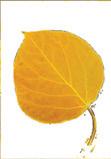

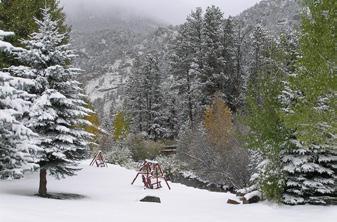
EXPERIENCE the splendor of the Rockies at Aspen Winds. The secluded setting along Fall River, among the aspen and pines, offers a relaxing atmosphere. Aspen Winds is located minutes from Estes Park and Rocky Mountain National Park. We offer one and two bedroom suites and in-room spa suites.
Kitchen/Kitchenettes • Gas Fireplaces
Fire Pit • Free WiFi • Cable/Blue-ray DVD No Pets • Non-smoking
970-586-6010 • 1-800-399-6010
1051 Fall River Court • Estes Park, CO ASPENWINDS.COM

Test your knowledge of our state’s sports trivia. by BEN KITCHEN

1


Experience historic charm at the Frisco Lodge. Our exceptional hospitality, après ski, soup bar, romantic courtyard with outdoor fireplace and hot tub are just a few reasons our guests rated us the #1 bed & breakfast in Frisco and all of Summit County!
The Colorado Avalanche have been to three Stanley Cup Finals, winning all three. Their first victory was during their first season in Denver, which took place after relocating from what Canadian city?
2
Before Nikola Jokic joined the team, the closest a Denver Nugget came to being named NBA MVP was in 1978, when what Hall of Famer came in third behind Bill Walton and George Gervin? He is not related to a certain shooting guard on the Golden State Warriors.
3 On Oct. 6, 1990, the Colorado Buffaloes beat the Missouri Tigers 33-31 in a football game, a victory tarnished by the referees allowing Colorado what advantage on their final scoring drive?
4 In 2018, which Colorado skier became the youngest ever to accrue 50 wins in skiing World Cup races? Just four years prior, she became the youngest ever to win an Olympic gold medal in slalom at the Sochi Games.
5
Coors Field has hosted two MLB All-Star Games, both of which have been notable in different ways. The 1998 game was the highest scoring ever, while the 2021 contest was relocated from what other city to protest a recently passed voting law?


6
The Denver Broncos played in three Super Bowls in the 1990s, facing the following three teams and winning twice. Which team did they lose to?
a. San Francisco 49ers
b. Green Bay Packers
c. Atlanta Falcons
7 Surprisingly, two members of the U.S. women’s national soccer team grew up together right here in Colorado. Jaelin Howell and Sophia Smith were both born in what northern Colorado town before attending high school together in Fort Collins?
a. Louisville
b. Superior
c. Windsor
8 In 2018, a “name the team” poll was held to determine what the successor to the Colorado Springs Sky Sox would be called. Which of the following team names was not one of the final options in the poll?
a. Colorado Springs Happy Campers
b. Rocky Mountain Oysters
c. Rocky Mountain Vibes
9 Which 6-foot-4 guard, who played for the Boston Celtics in the most recent NBA Finals, is the only current NBA player to be born in, go to high school in and attend college in Colorado?
a. Robert Williams III
b. Derrick White
c. Payton Pritchard
10 The Broncos have retired three jersey numbers: 44 in honor of Floyd Little and 7 and 18 in honor of two quarterbacks. Which of the following quarterbacks is one of the two so honored by the team?
a. Frank Tripucka
b. Craig Morton
c. Peyton Manning

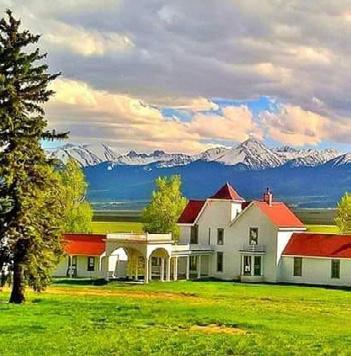
11
Colorado schools have won the most NCAA Division I Frozen Four hockey championships, with a combined 11: University of Denver has nine, while Colorado College adds another two.
12
Colorado Springs-born Danielle Page won a bronze medal at the 2016 Summer Olympics in basketball, representing Serbia and leading the team in rebounds during their final game.
13
Larry Walker is the only MLB player enshrined in the National Baseball Hall of Fame in Cooperstown, New York, whose primary team is the Colorado Rockies.
14 At the 2022 Winter Olympics, Olympians from Colorado won more gold medals than competitors from any other state.
15 The Colorado Avalanche are the only NHL team undefeated in Stanley Cup Finals appearances.
No peeking, answers on page 68.














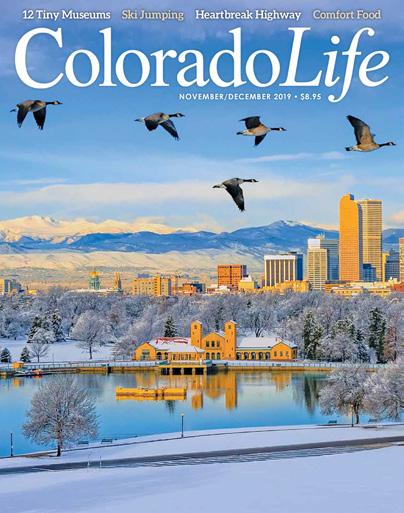

The perfect coffee table companion! Fill your home with stories that capture life in Colorado. Treat yourself or give the gift today.
Become a Subscriber 1 YEAR $25 2 YEARS $ 44


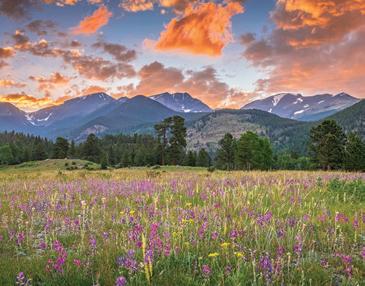



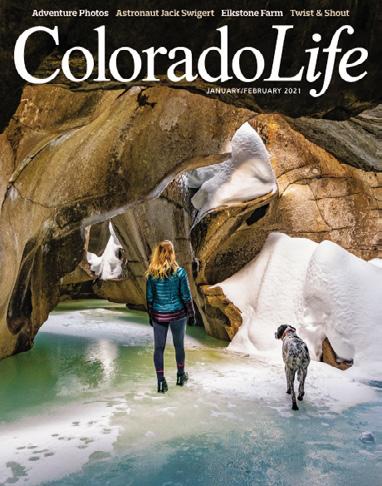
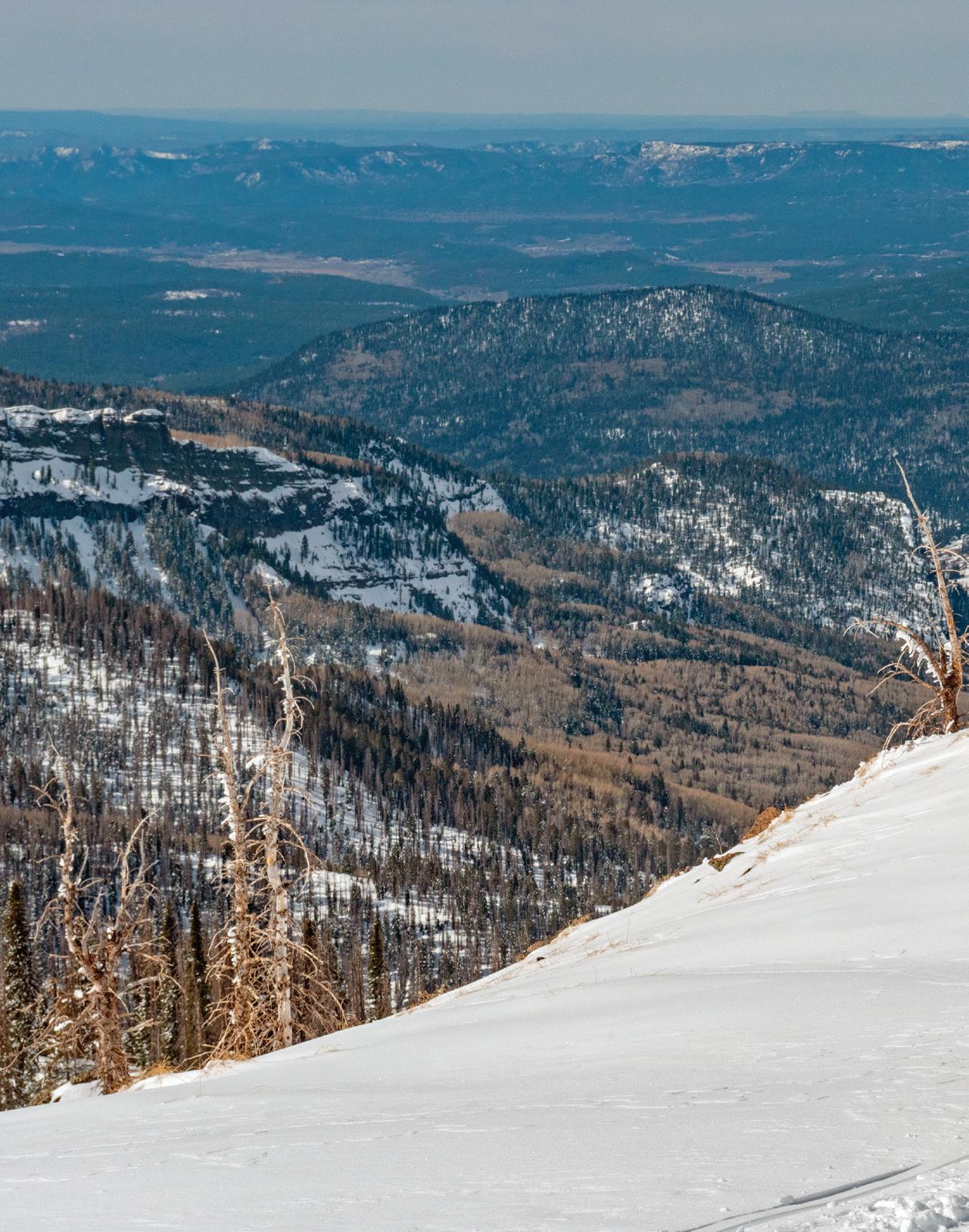
Pagosa Springs family braves backcountry terrain to guide guests to the ‘steep and deep’
story and photographs by
JOSHUA HARDIN
SNOW SEEMS TO have the magical property to morph into impossible shapes when it amasses in the ruggedly magnificent San Juan Mountains. It churns into ribbon candy-like swirls along canyon ledges, stacks over boulders like snowmen and frosts trees with twisting forms only comparable to Dr. Seuss illustrations.
Motorists traveling on Wolf Creek Pass east of Pagosa Springs may briefly sight this pristine seasonal splendor as they cruise over the crest of Highway 160 at 45 mph in comfortably enclosed vehicles. There are no paved roads leading to the peaks towering above the picturesque pass. For those beckoned to further explore those wintry heights, one of the only ways of reaching them is by snowmobile shepherded by a pair of modern pathfinders.
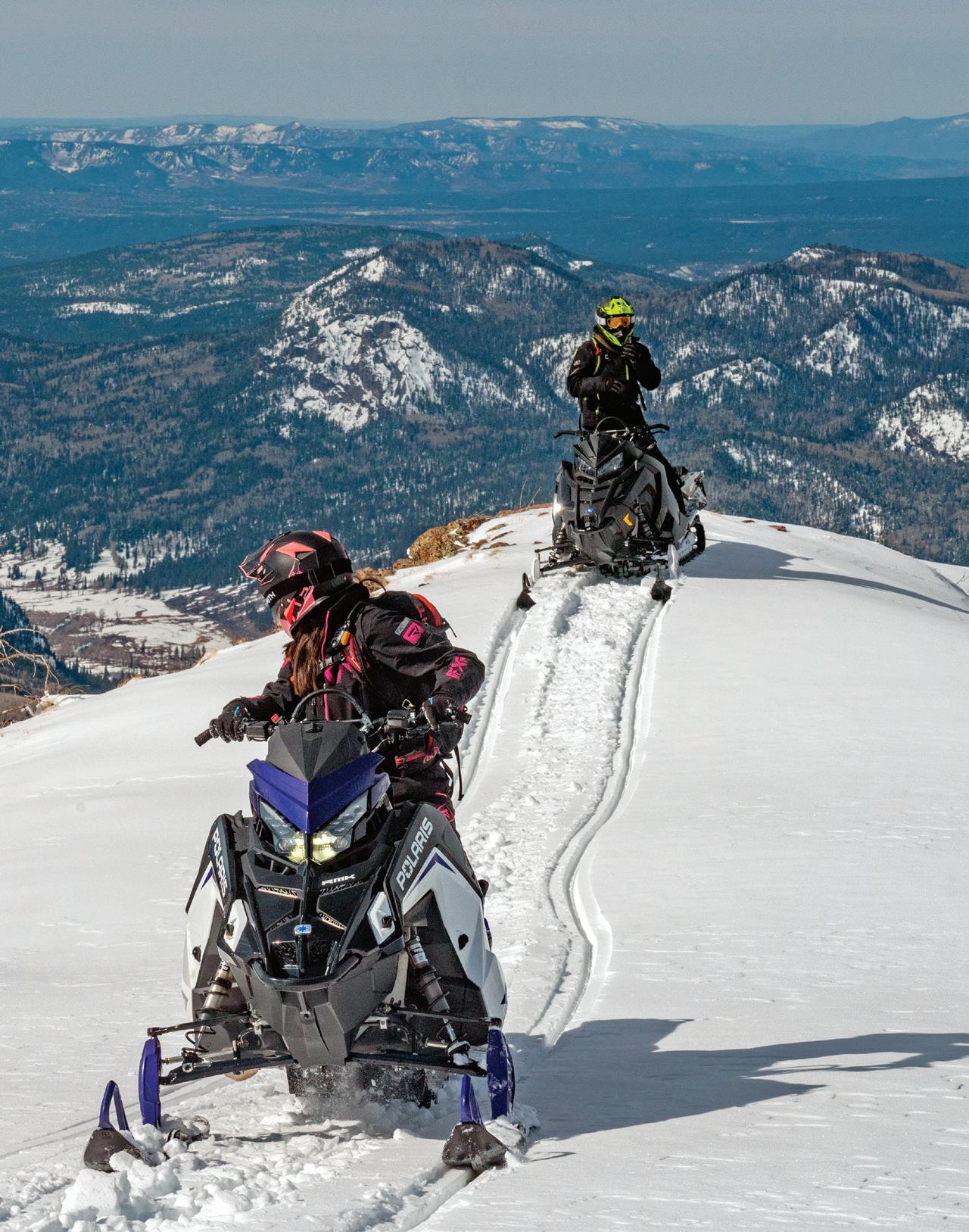
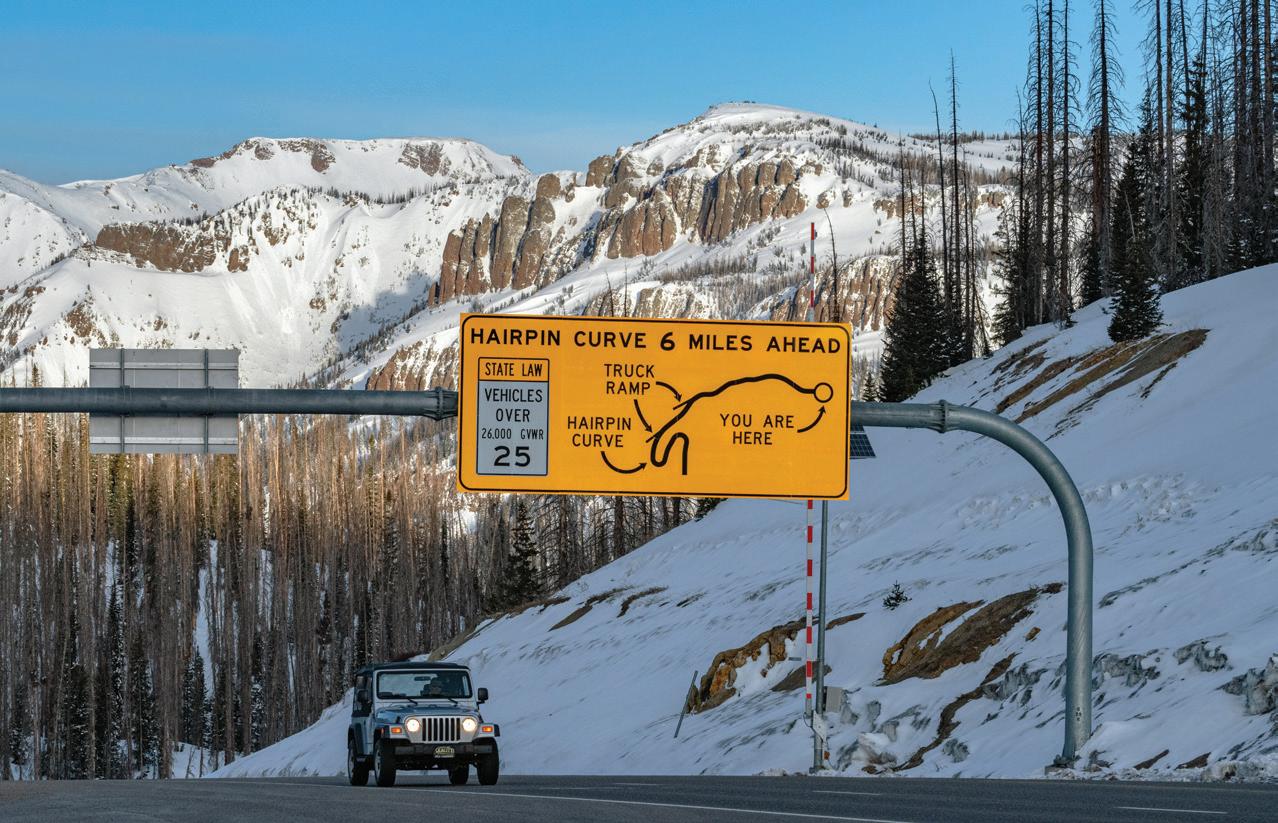
FOREST AND JACLYN Bramwell, owners of SnowCountry Snowmobile Tours, have guided riders, even those who have never saddled a snowmobile before, into the backcountry for more than a decade. The couple put close to 3,400 people on snowmobiles in the 2021-22 season alone.
Mountains run in the blood of both of the Bramwells, who grew up exploring the outdoors surrounding Pagosa Springs. Forest’s great-great-grandparents homesteaded in the late 1800s with covered wagon teams and logged the area to establish ranching operations. Back then, it used to take a week to travel over Elmwood Pass, as Wolf Creek Pass was then called. Today the highway makes the traverse possible in less than an hour.
In the late 1940s, Forest’s grandfather started one of Colorado’s first commercial outfitting and big game hunting businesses. Like his grandfather and father before him, Forest grew up organizing hunts and riding horses but had an inkling for even
more adventurous activities.
Forest rodeoed professionally for 10 years. He won an all-around title in college but specialized in the spine-thrashing event of bareback riding. He won reserve rookie of the year in 2000, made his first National Rodeo Finals a year later and ranked fifth in the world by 2003, amassing more than $750,000 in career payouts.
“Then my body started talking to me,” he said. A hip replacement in 2007 ended his rodeo career. “Like any professional athlete, I was the best in the world in what I did, but my body was all beat up. I thought, what do I now? I missed the adrenaline.”
Forest decided to return to Colorado and convinced his dad to sell him the family business, Third Generation Outfitters. The homecoming would lead to meeting future wife, Jaclyn, who worked as a trail guide for Forest’s parents. The mountains had always attracted Jaclyn since moving to Pagosa Springs from Illinois when she was 4. Her aunt and uncle also worked for Forest’s parents clearing trails and guiding
horseback rides.
“Her aunt worked right along with the men running a chainsaw and clearing trails, so I knew their family history since I was a boy,” Forest said. “I always loved their relationships. They did everything together. I thought if they ever have a daughter or niece someday, I better marry that girl.”
Jaclyn said yes to Forest’s proposal. The newlyweds ran the outfitting business in the summer and fall months but needed something to offer clients from November through April. Snowmobiling sparked their interest when the couple bought several old “sleds” from garages, shined them up and started taking people out to ride at a local ranch they rented.
Working year-round seven days a week, the couple saved enough money to buy out a fellow tour operator who possessed a string of valuable permits – including one of only two ever granted to access the top of Wolf Creek Pass. Expansion brought new staff and equipment too. The Bramwells now run nearly 50 four-stroke snow-
mobiles and employ six guides. Through it all, Forest and Jaclyn continually added to their snowmobiling and backcountry knowledge.
YOU START IN a school of hard knocks if you’re a snowmobiler. High speeds and jumps are featured attractions when riding on flat ground, but mountain riding requires more handling ability to maneuver up to 600-pound snowmobiles, as Forest learned after buying his first mountain machine, a Ski-Doo 800 Rev.
He started out riding with companions who had grown up with snowmobiles, and whose skills far outpaced his. He was discouraged his first dozen or so rides. “Oh, my goodness, what did I get myself into?” he remembers thinking. “We’re on the side of a mountain, and I don’t know how to ride this thing.”
Jaclyn also experienced a learning curve while joining her husband on her Ski-Doo 380 as they became serious about the sport.
Mentor and X Games medalist Chris Burandt approached the Bramwells about leading advanced lessons for their company. He knew Wolf Creek’s excellent snow quality and oversaw the lessons for three years. To be around someone of his experience greatly improved the Bramwells’ own riding skills.
The Bramwells practiced for years to improve their ability level in Wolf Creek’s steep terrain, which is why those expecting to quickly be jumping and flipping with the skill of a TV-star X Games athlete are in for humbling trials. Extreme sports are backbreaking work – sometimes literally.
Forest broke his back three times during his rodeo career, and once more while snowmobiling in May 2021. He dropped into a melted-out boulder field, and his snowmobile rolled nose-to-tail about five times. Jaclyn saw the crash, pitched her snowmobile and ran to him. Forest immediately knew he broke his back but could feel his fingers, an encouraging sign.
“I’m like, well, I should probably call a helicopter, but let’s go ahead and try to just ride out,” Jaclyn said. “The trails were hard and bumpy, and his snowmobile was in pieces, so we were able to double with mine and get him to the hospital.”
As trained backcountry guides, both


Forest Bramwell unloads a snowmobile from a trailer prior to heading out for a ride; before he took up snowmobiling, Forest rode bareback broncs as a rodeo cowboy. Steering a snowmobile is similar to steering with the handlebars of a bicycle.
Bramwells learned how to mentally switch into survival mode, but Jaclyn cried once she got Forest to the hospital. Doctors found five different breaks in his back, including a C7 vertebra break common in motor sports, since helmets don’t cover the upper neck.
With a hip replacement and a C7 that hasn’t fully healed, Forest jokes that he isn’t Iron Man, but you can call him Titanium Man. This makes going though airport security metal detectors a tricky experience.
“His face has been reconstructed, so he has a plate in his face,” Jaclyn said. “You could actually feel the screws if you run your finger along his eye socket.”
A trip when Forest was swept into an avalanche may have been even scarier than his back-breaking crash. He wasn’t expecting trouble, as he wasn’t in an avalanche chute.
“Then I just came out a little bit and felt the earth drop out from underneath me, and your heart sinks,” he said. “I knew immediately what was going on.”
Forest tried to outrun the avalanche’s edge, but it blew him off his snowmobile. He rolled down a slope for several feet but remained near the top of the slide. The avalanche buried him except for his head, which stuck above the snow. Jaclyn, who was following him, luckily avoided the slide and returned to their group of riders, one of whom had avalanche training and quickly dug Forest out.
“I was starting to suffocate even through my helmet. It was packed in my mouth, my ears, my nose,” Forest said. “You can’t move. Your arms are just totally pinned. It feels like concrete when it settles. It almost smashes the wind out of you. You can’t breathe.”
Forest’s extensive first aid and CPR training taught him to stay calm and keep his heart rate down. Nevertheless, anyone can panic when thoughts of a possible death encased in snow enter their mind. “My heart was racing, and I was thinking, oh boy, this might be my last breath,” he said.
Despite the danger, the couple have realized benefits from being in places few dare to venture. They constantly strive to improve their skills so they can venture

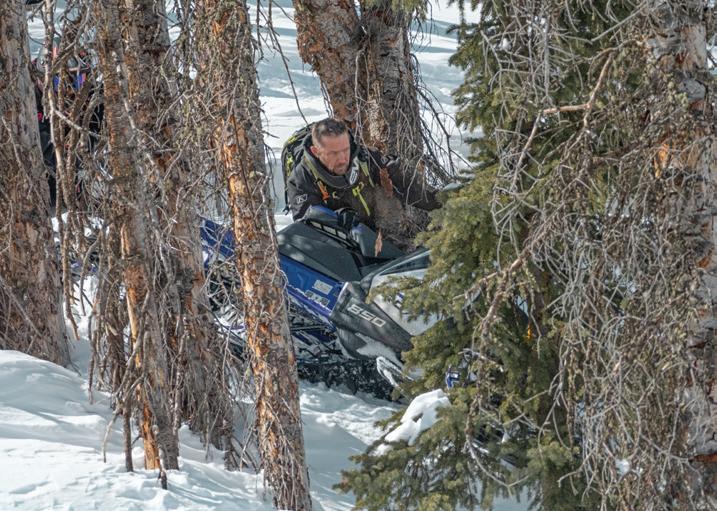
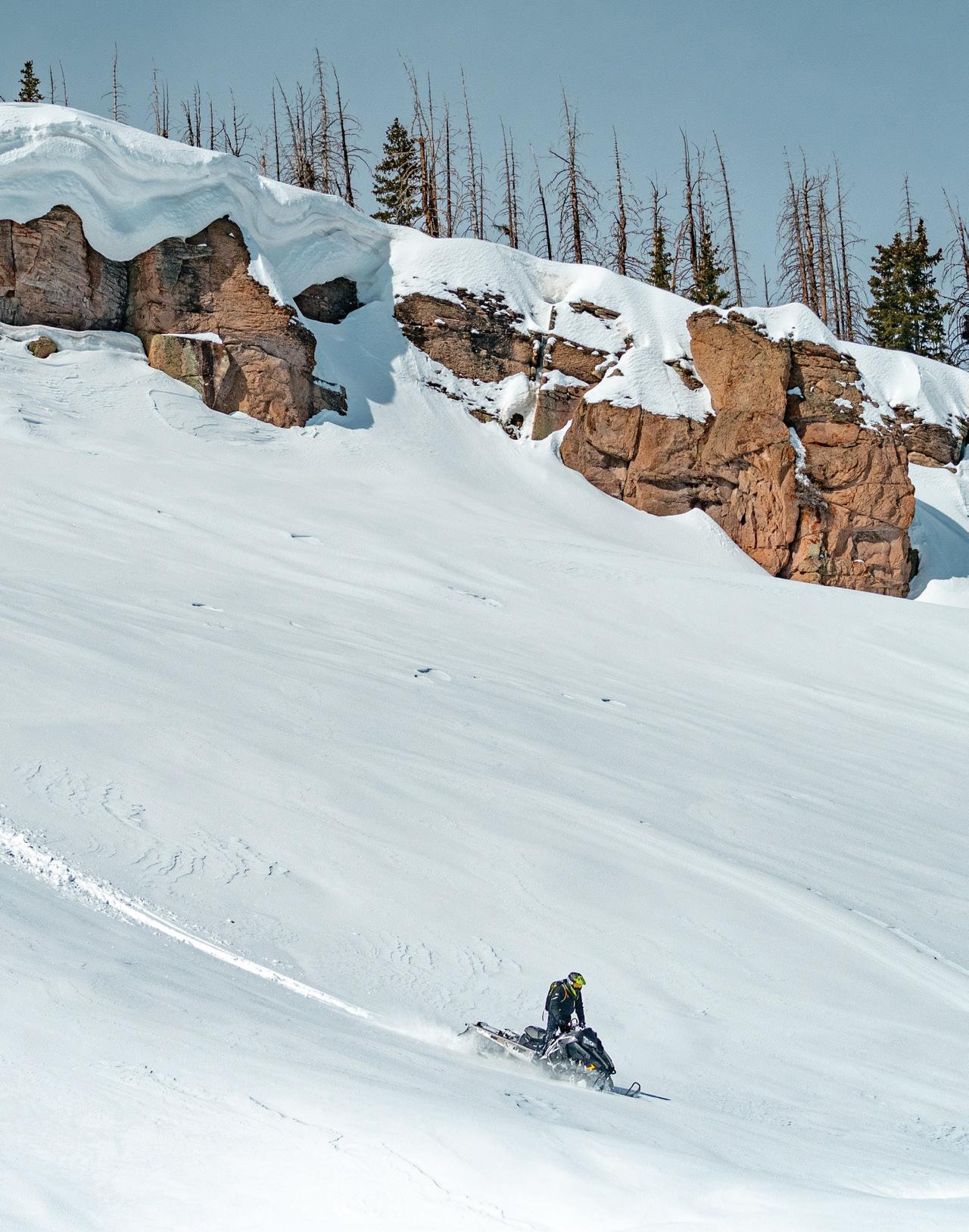
Forest Bramwell blazes a path down a steep slope of pristine snow.

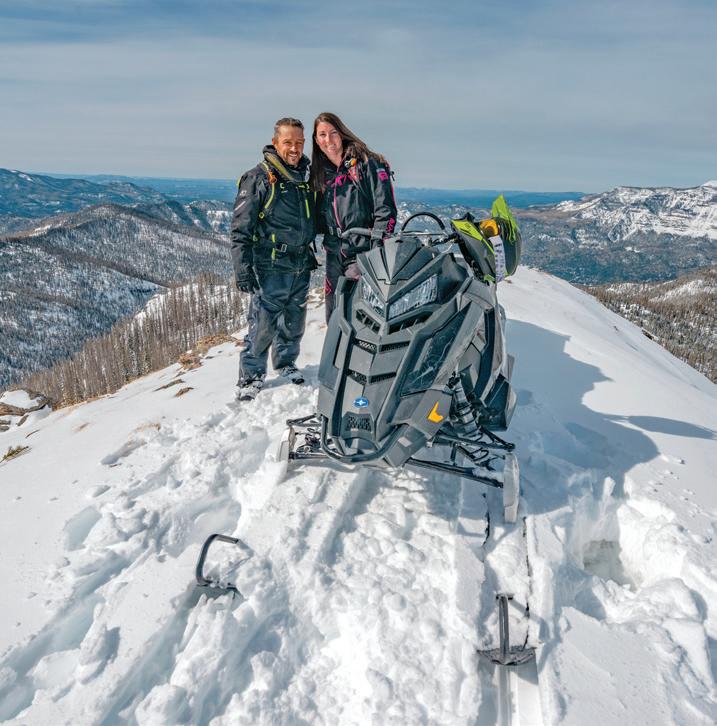
further into uncharted territory.
“When I’m at the top of these mountains I get a rush, a wonderful feeling that I can’t get from anything else,” Forest said. “I’m scared of heights, believe it or not.”
Bramwells the most is inviting others to experience some of the most beautiful scenery anywhere on top-of-the-line equipment.
The couple is delighted at how many guests are already awed by the terrain when they get out of their car at the parking area but are blown away even more when tours go deeper into the spectacular landscapes. During one leisurely trip, Forest’s uncle described driving a touring snowmobile as “like riding a couch around in the mountains.”
Not all trips are so simple. The business can involve dealing with inclement weather and hauling heavy loads on steep passes. Snowmobiles get stuck and are also “tree magnets.” Still, the company’s safety record is impressive, and serious injuries are rare. The Bramwells recall only having a couple of instances where someone broke a bone, one of which happened when a client decided to pull alongside his wife to wave at her.
“We tell everybody to ride in single file, but he shoved the snowmobile into a ditch and went over the handlebars,” Forest said. “He’s a tough son of a gun. He played college football, and he’s a big, big guy. He broke his femur. That’s probably the only bone I haven’t broken yet.”
Because the tour had just started, the injured man chose to sit in the truck for two hours to let the rest of the party enjoy their ride. “You know he’s in pain,” Forest said, “but he’s like, ‘No, no, I’m an idiot. I’m going to sit in the car and suck it up.’ ”
Jaclyn stayed to continue checking on his vitals while he waited to go to the hospital, as the rest of the family, including his wife, continued the two-hour tour.
“Oh, the big dummy. He knows better than that,” the wife said, according to Forest.
Couples and families comprise most tours. Passengers can be 4 years old and up; 16-year-olds can drive. The Bramwells believe their oldest driver so far was 82 years old and consider repeat customers like family. One client who rode a snowmobile

The San Juan Mountains around Pagosa Springs is a favorite destination for many snowmobilers. When guests ride with the Bramwells, many people are awed by the view from the parking area only to be blown away by the vistas on the actual tour.
as a little boy with Forest’s late grandfather returned decades later to tour with Forest and make memories for his own children.
Clients come from all over the world. Recently, Forest could tell something was troubling a nervous rider and discovered she had family in Ukraine during the onset of the Russian invasion. Forest admits putting her mind at ease was emotional knowing her country was under siege.
“Forget everybody else that’s on the tour,” he said. “It’s just you and me right now. We’re just hanging out in the mountains. I’ll take care of you.”
ASSOCIATION sticker sales and fundraising by clubs like Wolf Creek Trailblazers, where Forest is president and Jaclyn is treasurer, pay for the access permits and trail grooming that make tours possible. The
Bramwells also help organize Snowdeo, a membership drive for both organizations at the Archuleta County Fairgrounds. Events include a barrel-pattern ride with radically tight turns, hidden safety beacon hunts and rides for kids. More than 100 spectators attended last February.
Giving back to the growing sport’s community also means minimizing its impact on the land by investing in efficient and ecofriendly equipment. SnowCountry’s snowmobiles are quiet enough to approach an elk herd without scaring them away, Forest said.
“My family has been in it longer than anybody. We’ve always taken care of the national forest, and it’s a way for us to make a living. Why would we tear it up? Because that’s tearing up your own future,” he said as he pointed to a rocky snow-coated ridge. “I’ve tried to park my
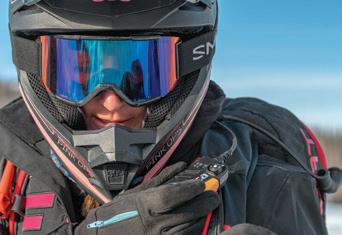
sled on top of every one of these peaks, and I don’t ever want that to be stopped. Once all the snow melts, it looks like we were never there.”
Snow will soon fall again in the San Juan Mountains, creating a frozen playground. The Bramwells will surely be there to show hundreds of new visitors on snowmobiles the winter wonderland waiting above Wolf Creek Pass.

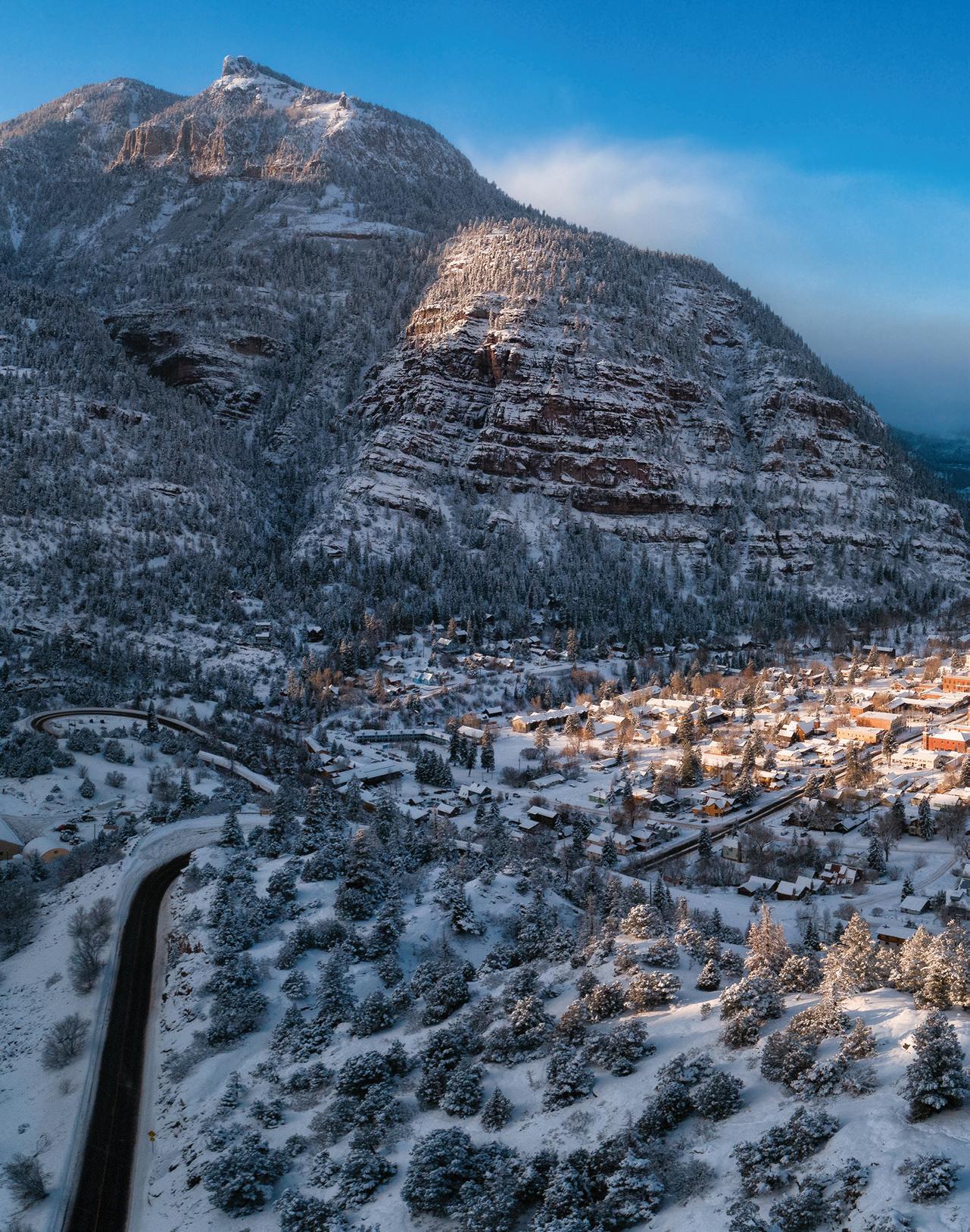
In Ouray, all paths lead to outdoor adventure
Snow shrouds the town of Ouray, nestled between the steeply rising slopes of the San Juan Mountains.
Mike Boruta
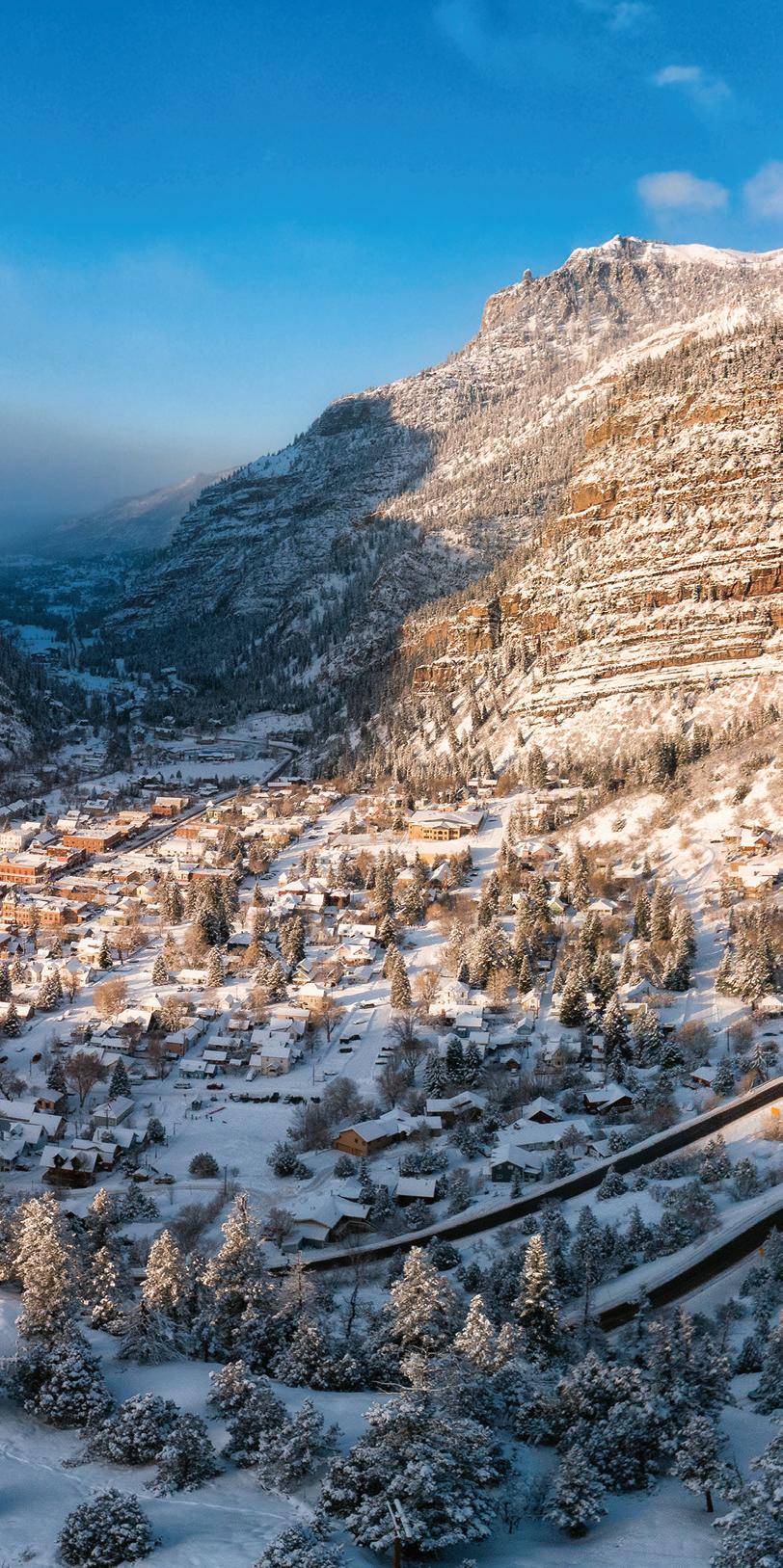
EVERGREENS GROW FROM precarious rootholds on the cliff face of the narrow canyon that encloses Ouray, a town of 1,000 people in the San Juan Mountains of southwest Colorado. The canyon runs north-south, with the Uncompahgre River rippling its course along the cliffside.
Steam rises at the north end of town from the city-owned Ouray Hot Springs Pool and Fitness Center. There are actually five pools here, three of which are geothermally heated from a natural hot spring. The air is so still that the susurrous sound of snowflakes hitting the ground is clearly audible. The people relaxing in the pool’s mineral waters feel like they are in their own private snow globe, yet they feel perfectly comfortable – the water in the hottest pool is as high as 106 degrees.
A mile south, at the other end of town, a wall of bluish ice plunges more than 100 feet down the side of Uncompahgre Gorge. This is the Ouray Ice Park, the wintertime mecca for ice climbers around the globe. Using spiky crampons on their boots and handheld ice tools that make them look like praying mantises, the climbers gradually pull themselves up the park’s frozen waterfalls.
Connecting the hot springs pool and the ice park is Main Street, home to nearly all of the businesses in Ouray. It is also just about the only paved road in town – the residential side streets are mostly dirt and gravel.
From the Victorian architecture that dominates Main Street, it is easy to peg Ouray as a former mining boomtown. Before the gold and silver miners arrived in the 1870s, this land was the home of the Uncompahgre band of Utes; the band’s famous Chief Ouray (pronounced “youRAY”) is the town’s namesake.
The shops and restaurants lining Main Street do a bustling business in the wintertime. That was hardly the case when Bill Whitt moved to town more than 30 years ago.
“Back then, you could lay in the middle of Main Street in January and not get run over,” Whitt said. “There was nobody here.”
Though Ouray has long been a magnet for Jeepers and hikers in the summer months, winters used to be eerily quiet –
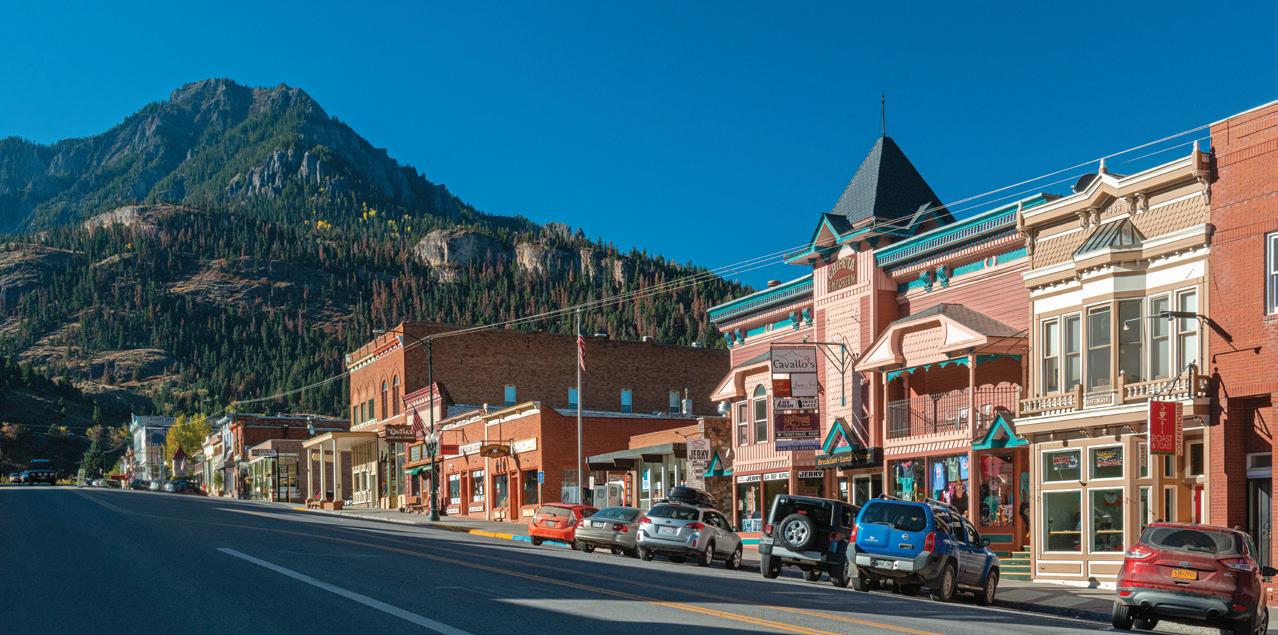
especially after the local mines closed down in the 1980s. That all started to change after Whitt got the inspiration to create the Ouray Ice Park.
The ice-climbing routes in the ice park aren’t naturally occurring. The first ice wall in Uncompahgre Gorge started thanks to a leaky water pipe connected to the town’s old reservoir. Hoping to expand the climbing, in 1991, Whitt and business partner Gary Wild began to tap the pipe with lengths of hoses connected to showerheads to create manmade waterfalls that would freeze into additional routes up the gorge.
They loved ice climbing, but Whitt and Wild had more than personal recreation in mind. The two had just purchased the Victorian Inn in Ouray. They kept the hotel open through the winter, which was unusual; only one other hotel in Ouray stayed open past the fall. If they rented even one room in January, they considered it a victory – at least it wasn’t a shutout.
Whitt figured that by promoting the sport in Ouray, it might liven up the town in the dead of winter. At first, many people in town were skeptical.
“When we started getting it going, a lot of the locals thought it was the stupidest thing ever,” Whitt said.
It was an admittedly goofy setup. The hoses would always freeze, requiring
Whitt to drag the “frozen snakes” back to the Victorian Inn to thaw them out in the hotel’s hot tub.
There were other challenges beyond frozen hoses. Most of the land in the gorge was on the property of the Ouray Hydroelectric Power Plant. The plant’s owner, Eric Jacobson, wasn’t inclined to let people climb on his land for fear he would be held liable if they got hurt.
Fortunately, Wild was a lawyer who knew that Colorado law protects land
owners from liability if people get hurt recreating on their property. Wild went over to Jacobson’s office with a six-pack of beer to explain the situation, and by the end of the meeting, they’d struck a deal to allow climbing to continue.
From those beginnings, Ouray Ice Park grew. It had its first official season in 1994, followed by the first Ouray Ice Festival in 1996, founded by the renowned alpinist Jeff Lowe. The park is now an official Ouray city park that is free for anyone to

use. Today, Ouray Ice Park has 14 employees, including four full-time “ice farmers” whose job it is to spray water to freeze into the park’s walls of ice.
There isn’t another town on the continent with a public ice park comparable to Ouray’s. It has become the epicenter of ice climbing in North America and a regular training ground for the world’s top climbers – many people who have summited Mount Everest have trained here.
Held each January, the Ouray Ice Festival has become a highlight of the year in town, with thousands of people in attendance. This year, the festival was joined by two other events: the North American ice climbing championship and the All In Ice Fest, which promotes ice climbing among historically marginalized communities.
For the younger generations in Ouray, the ice park has been a constant in their lives. Logan Tyler, a Ouray native and member of the USA Ice Climbing Team, began climbing in the park at age 8. By the time he was in high school, ice climbing was all he could think about.
“I’d show up late to classes because I was in the ice park trying to get pitches in on my lunchbreak,” Tyler said. “My teachers were like, ‘You’re soaking wet! What are you doing?’ ”
When he wasn’t climbing, he was hanging out on Main Street at Ouray Mountain Sports, the climbing and outdoors shop that is the hub for outdoor adventurers in Ouray.
Tyler’s interest in climbing of all kinds led him to a career as an industrial climber ascending cellphone towers. While still in his 20s, he was in charge of two tower crews climbing towers across the Midwest. That career came to an end in 2015, when he was hit by a drunk driver and nearly killed. He had to have his jaw wired shut, and for six months, he couldn’t walk, talk or eat.
It was in the hospital that he decided on a new career path.
“I woke up, and nobody was there – no clients, no boss,” Tyler said. “All the stuff I thought mattered didn’t. In that moment, I knew I was never going to work for somebody else’s dream again.”
Tyler decided to return to Ouray to follow his own dreams. He founded outdoor guiding company Basecamp Ouray and opened an indoor climbing gym in a for-
mer theater on Main Street, which is now called the Ouray Adventure Center.
Last year, he launched a new adventure by building his own via ferrata. Italian for “iron way,” a via ferrata is a course that travels along a cliffside on steel rungs driven into the rock. He led a team working 14hour days for three months to create the Gold Mountain Via Ferrata, which partly travels through the old Memphis Mine.
When he leads clients on tours of the via ferrata, the most mentally challenging part is a 273-foot-long five-cable bridge
that traverses hundreds of feet above the ground. To navigate the via ferrata, people must overcome their fears and live completely in the moment, Tyler said.
“We’re taking people out of their comfort zone,” he said. “When you introduce a certain amount of vulnerability, people connect with themselves and others on a deeper level.”
While Ouray is proud of its unofficial status as the outdoor adventure capital of Colorado, it is entirely possible to enjoy the town without adrenaline-pumping out-

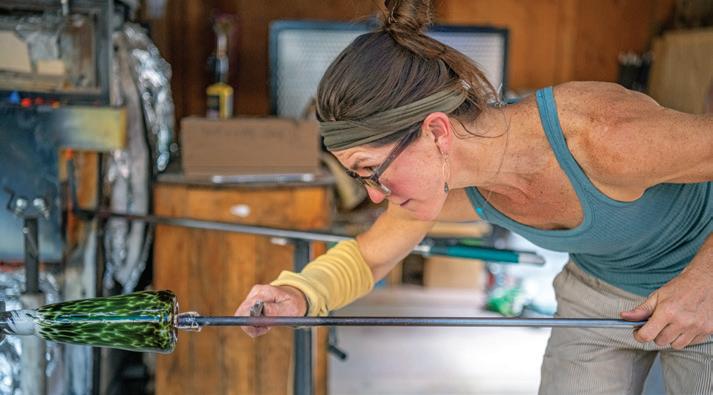
door pursuits. Many people spend the day walking up and down Main Street to visit the locally owned shops and restaurants.
It is difficult to tell the historic buildings from the newer construction. The Ouray Brewery, built in 2010, is a popular spot with tourists and locals. The beer is brewed on-site, and the food is served on a rooftop dining area with views of Main Street and the mountains beyond.
Perhaps the jewel of Main Street is the Beaumont Hotel, a grand Victorian edifice that first opened for business in 1887. In its heyday, it hosted visiting celebrities, including presidents Theodore Roosevelt and Herbert Hoover. But as Ouray’s fortunes declined in the mid-20th century, the hotel fell into hard times and closed in 1967.
The Beaumont remained shuttered for more than 30 years. Before it closed, its then-owner inexplicably painted its beautiful brick exterior pink, leading locals to refer to the vacant building as the “pink elephant.” But with business picking up in Ouray, new owners decided to restore the Beaumont, starting with removing the pink paint. The hotel reopened in 2003, and it is once again an elite destination, hosting such luminaries as Oprah Winfrey and the singer Jewel.
Restoring Ouray’s historic places has become a theme in town. Catercorner from the Beaumont is the Wright Opera House, which opened a year after the hotel in 1888. Despite its name, no opera has ever been performed at the facility – “opera house” was a sort of code used in the Old West to let people know that that the place showed decent, family-friendly entertainment.
The Wright Opera House fell into disrepair over the years. In 2011, a local nonprofit raised money to purchase the opera house and spent a decade restoring it. The opera house is now a community gathering place for events, plays and movies.
In years past, one of the signature programs at the Wright Opera House was the San Juan Odyssey, a multimedia show with five screens and 15 slide projectors displaying images of the San Juan Mountains that surround Ouray. Orchestrating the show and narrating it was Bill Fries, better known as C.W. McCall, who hit No. 1 on the Billboard charts in 1976 with his novelty country hit “Convoy.”

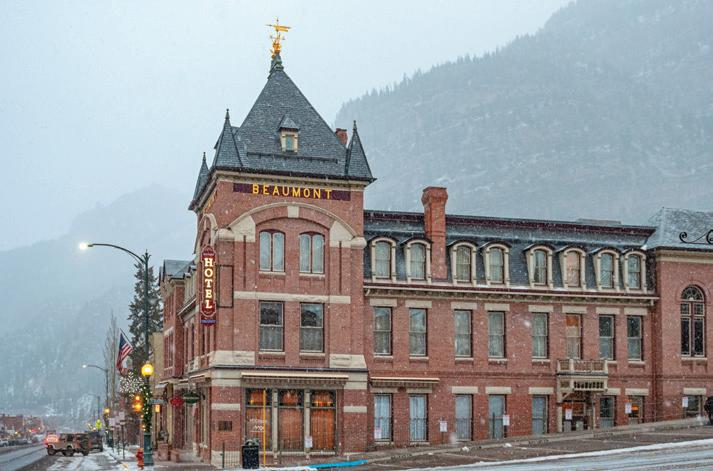
An Omaha native, Fries’ heart was always in Ouray, and he moved here after he hit it big with “Convoy.” In the 1980s, he even served as the town’s mayor, helping oversee the renovation of its historic town hall. Ouray and environs popped up in Fries’ songs – for instance, “Riverside Slide” is about the snowplow drivers who brave avalanches and hairpin turns on the Million Dollar Highway, which winds along Uncompahgre Gorge south of town.
Fries died at age 93 earlier this year, but anyone who has lived in Ouray for any length of time has a story about him. Over at the Outlaw Restaurant, bartender Colleen Bixler tells stories about serving as city clerk when Fries was mayor; her other stories include the tale of John Wayne’s cowboy hat, which hangs behind the bar – a gift from the actor when he shot True Grit in the area.
Across the street, Fries’ daughter-inlaw Sue Fries minds the front of the shop at Ouray Glassworks and Pottery. When customers walk in to browse the shop’s glass vases, drinking glasses and oil de-
canters, and ceramic salad bowls, Fries informs them that everything is made on-site. She may even invite people out back to see store owner Annie Quathamer blowing glass. She twirls a glowing, molten blob of glass on the end of a long, skinny tube, through which she then blows to shape the blob into its final form.
Though Quathamer has lived in Ouray for more than 20 years, the town’s beauty still hasn’t gotten old. “I’ll be walking down the street and go, ‘Oh, it’s so pretty,’ and I’ll start taking pictures, just like the tourists,” she said. “I just feel so grateful to call this home.”
Citizens of Ouray are grateful to be able to live here. After all, finding a house to buy or rent is quite difficult. The town is confined to a canyon with little room to expand, and what few homes there are have skyrocketed in price in just the past few years. About half the houses are second homes whose owners generally only live there in summer. This forces many people who work in town to commute
from Ridgway or Montrose.
A bumper sticker that speaks to the full-time populace’s sometimes tense relationship with second-home owners has started appearing around town. It reads: “What do you mean there’s an employee housing problem? I own several vacant homes in Ouray.”
Local business owners have taken some creative measures to solve the housing problem. Last year, when the Ouray Chalet Inn – across Main Street from the Beaumont – came up for sale, the owners of San Juan Mountain Guides, Ouray Grocery, Ridgway Mountain Market and Twin Peaks Lodge joined together to purchase the motel to use as affordable housing for their workers.
Selling the Ouray Chalet Inn was emotionally difficult for Lora Slawitschka – her family had owned the motel for 50 years, and it had been her childhood home. “But to know that it is being used in a way that’s so beneficial to the community made the transition easier,” she said.
Climbers ascend sheer walls of bluish ice during the Ouray Ice Festival at Ouray Ice Park. Since the development of the ice park in the 1990s, Ouray has become the focal point for ice climbing in North America, hosting the continental championships in 2022.

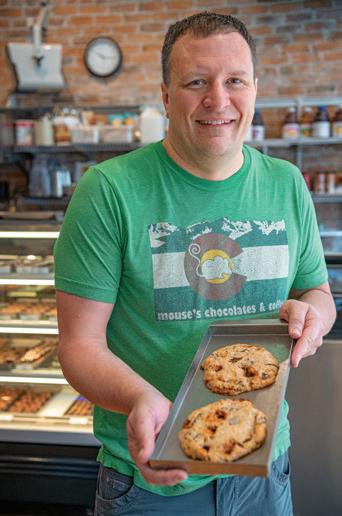
Main Street has its share of celebrity sightings. Sometimes the famous folks are visiting; sometimes they’re local, such as fashion designer Ralph Lauren, who has a ranch nearby. But of all the celebrities in Ouray, no one generates more excitement from passersby than the world-famous Dexter Dog.
When owner Kentee Pasek first brought Dexter home as a puppy, he was a normal Brittany spaniel, albeit one whose outgoing and affectionate demeanor made him beloved by students across the street at the K-12 Ouray School. But then, in 2016, young Dexter escaped from his yard, ran into the street was run over by a truck. One of his front legs had to be amputated. Pasek hoped he could use his remaining front leg to walk around tripod-style, but the elbow was too damaged to support his weight.
For two months, Dexter struggled to move, having to be carried outside to go to the bathroom. But one day, Pasek carried Dexter outside, down the porch stairs and to the lawn, then went back inside to get a cup of coffee – and when she returned, Dexter was somehow on the porch. She carried him back down, then watched in amazement as he hopped onto his hind legs and walked up the stairs like a human being.

At Mouse’s Chocolates and Coffee, owner John Weihert shows off some “scrap cookies” made with a mystery mix of leftover candy bits. Kentee Pasek walks Dexter Dog, a Brittany spaniel that started walking upright after its front legs were run over.
From that moment on, Dexter has been bipedal. People in town became accustomed to the sight of Pasek or a family member taking Dexter for a walk, the dog walking upright, standing an impressive 4-foot-2. Many in Ouray started following Dexter on Instagram.
In June 2020, a tourist from Arizona saw Pasek’s mother walking Dexter down Main Street and quickly took a cellphone video, then posted it on TikTok. The video went viral and soon was shown on The Tonight Show with Jimmy Fallon. Media from across the nation and beyond started clamoring to meet Dexter, who has now been featured on CBS Evening News, the BBC and much more.
Dexter hasn’t forgotten where he came
from – he still walks proudly in Ouray’s Fourth of July and Yule Night parades.
For the more than million people who follow Dexter on TikTok, Instagram and Facebook, he has become a symbol of overcoming adversity. But there’s something distinctly Ouray about him that people in his hometown recognize.
“There’s a tenacity about Ouray, a strength about Ouray,” Pasek said. “The faint of heart don’t live here. A lot of people love it for a moment, but we still have dirt streets and all kinds of weather. Many of us have chosen to quit huge corporate jobs and taken pay cuts to live here and make it work.”
Tenacious and strong, the people – and dogs – of Ouray keep walking tall.


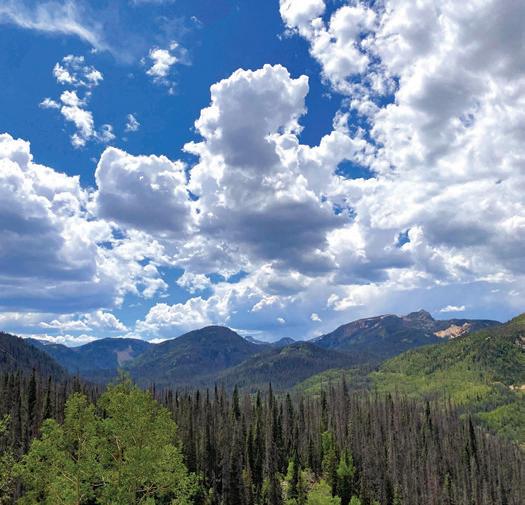













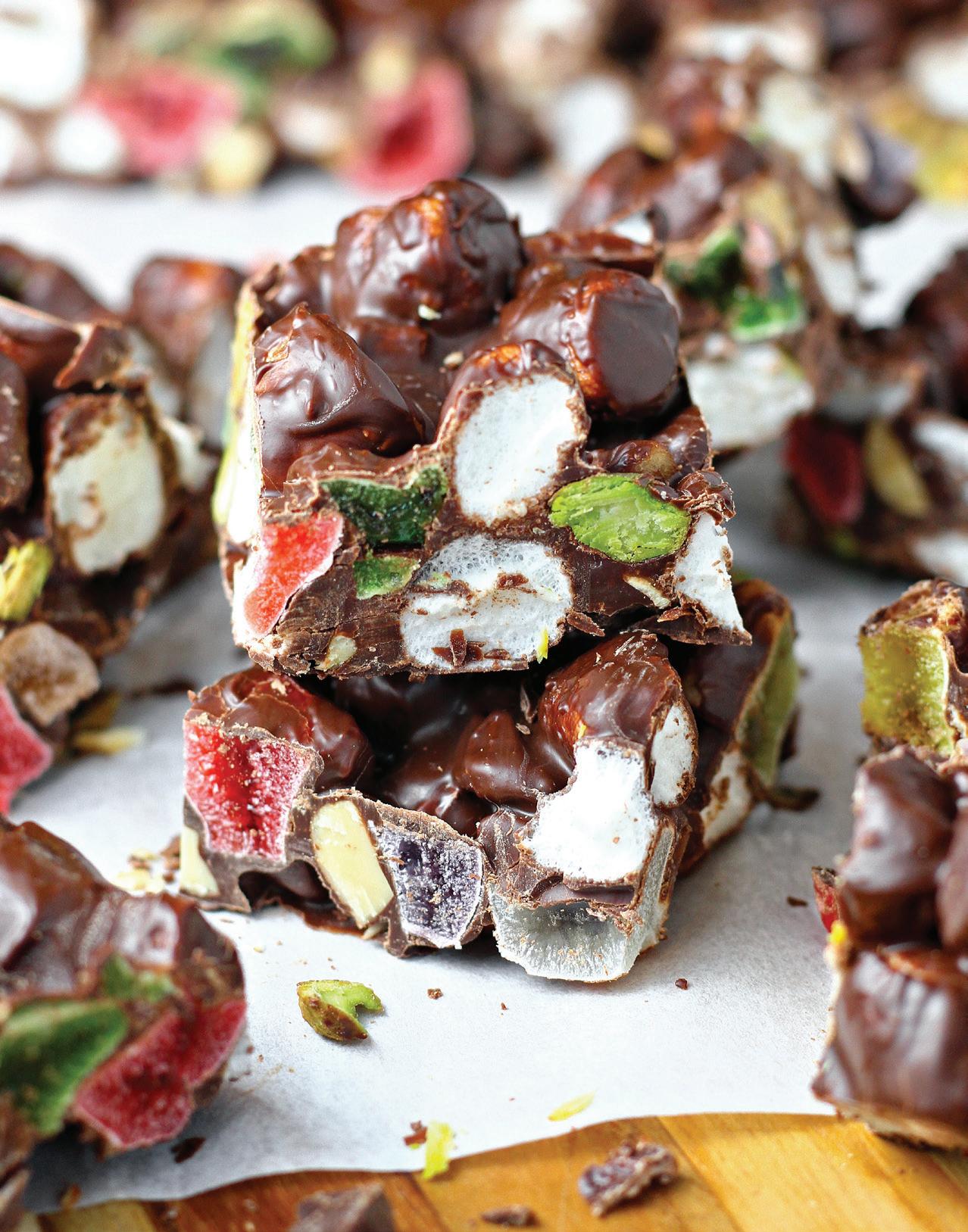
recipes and photographs by DANELLE
MCCOLLUM
CHRISTMAS CANDY HAS made major leaps in the nearly 200 years since “visions of sugarplums” danced in the heads of the wee ones in A Visit from St. Nicholas. These holiday candy recipes are a sweet reward for those on your “good” list, or a welcome dessert option for potlucks and other festive gatherings.
Traditional rocky road candy, made with chocolate nuts and marshmallows, gets an upgrade for the holidays with the addition of gummy candy. The recipe’s ratio of marshmallows, nuts and gummies comes after considerable research, but feel free to adjust the amounts or swap in ingredients to suit your taste. The recipe freezes well when wrapped in parchment, then foil. Four sections can be frozen, then deployed as needed, cut up into bite-sized pieces.
Line 10x15-inch jelly roll pan with parchment paper; set aside. Place marshmallows, gummy candies and nuts in large bowl. In microwave or double boiler, melt chocolate until smooth. Heat chocolate just enough for it to melt, but don’t let it get too hot. Working quickly, pour chocolate over marshmallow mixture and stir to combine. Pour into prepared pan and spread mixture into even layer. Let set, then cut into slices to serve.
1 10 oz bag dark chocolate chips
1 12 oz bag semi-sweet chocolate chips
8 oz miniature marshmallows
2 cups chopped gumdrops, Turkish delight, jujubes or other gummy candies
1/2 cup chopped roasted almonds
2/3 cup roasted pistachios
Serves 36

Soft and chewy, with the bold color and flavor of red-hot cinnamon, these caramels are a treat for the cinnamon lovers in your life. This recipe requires a bit of patience and a strong stirring arm, but the results are worth it. Be sure to use food-grade cinnamon oil, not cinnamon extract.
Butter 9x13-inch pan and set aside. In large saucepan over medium heat, combine sugar, corn syrup, cream and butter. Cook, stirring almost constantly, until mixture reaches 240°. This may take up to 30 minutes.
Remove caramel mixture from heat and stir in cinnamon oil and red food coloring. Pour into buttered pan. Let cool to room temperature, then refrigerate to set. Let caramel sit for 10-15 minutes at room temperature before cutting. Wrap individual pieces in wax paper for storing or giving away.
2 cups sugar
1 ½ cups light corn syrup
1 ½ cups heavy cream
1 cup butter, plus some for buttering the pan
2 tsp cinnamon oil
1 tsp red food color gel
Serves 12
A fudge base is topped with a layer of peanuts and caramel, then finished off with a layer of chocolate in this homage to the popular Snickers candy bar. In fact, this recipe eats like a cross between fudge and a candy bar, which is perhaps why it is well-received even among those who aren’t ordinarily fudge fans. Microwave times are for an 1100-watt microwave; your times may vary.
Line 8- or 9-inch square pan with parchment paper, leaving an overhang. Butter the parchment. In microwave-safe bowl, combine butter, cocoa, sugar and evaporated milk. Microwave on high until mixture boils, about 2 minutes. Remove from microwave and whisk until smooth. Mix in powdered sugar and vanilla extract. Use your hands to fully blend in powdered sugar, if needed. Spread evenly in the prepared pan.
In another microwave-safe bowl, heat caramels and water on high for 1 minute 15 seconds, or until melted. Stir in peanuts. Spread peanut and caramel mixture over fudge layer in pan. Microwave chocolate chips and vegetable oil at 50-percent power for 1 minute; stir. Continue to microwave at 15 seconds intervals until completely melted and smooth. Spread melted chocolate over caramel layer.
Chill until firm. Bring to room temperature before serving.
1/2 cup butter
1/3 cup cocoa
1/4 cup sugar
1/4 cup evaporated milk
3 ½ cups powdered sugar
1 tsp vanilla extract
30 caramels, unwrapped
1 Tbsp water
1 ½ cups salted peanuts
2 cups chocolate chips
2 tsp vegetable oil
Serves 36

The editors are interested in featuring your favorite family recipes. Send your recipes (and memories inspired by your recipes) to editor@coloradolifemag.com or mail to Colorado Life, PO Box 146, Timnath, CO 80547.

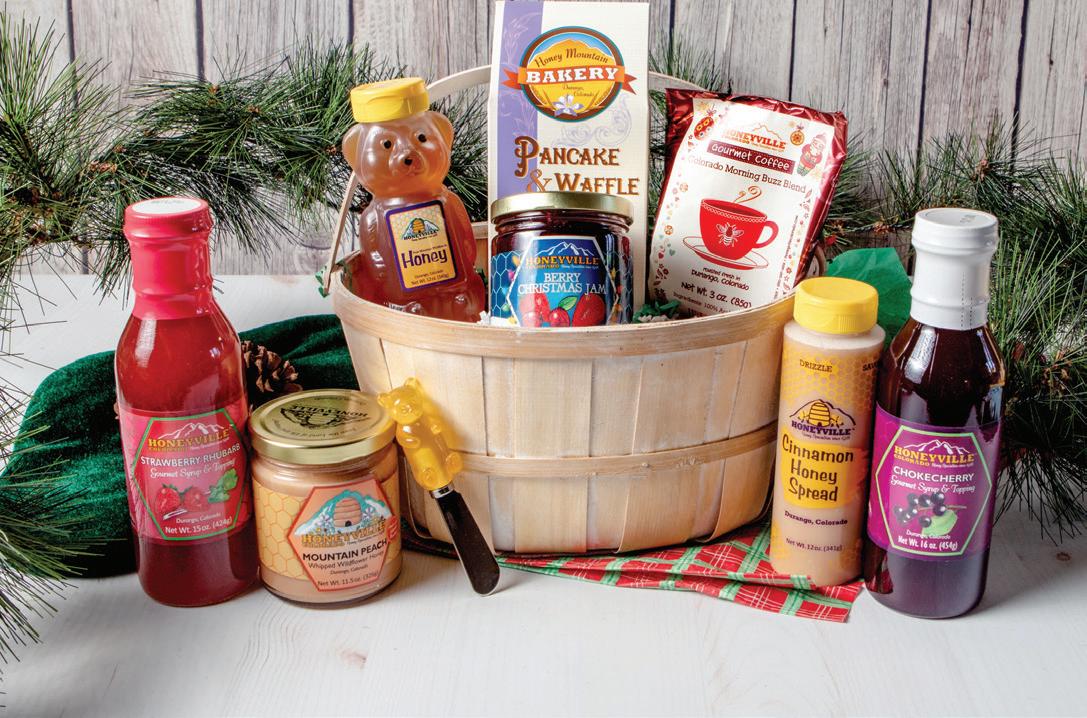

















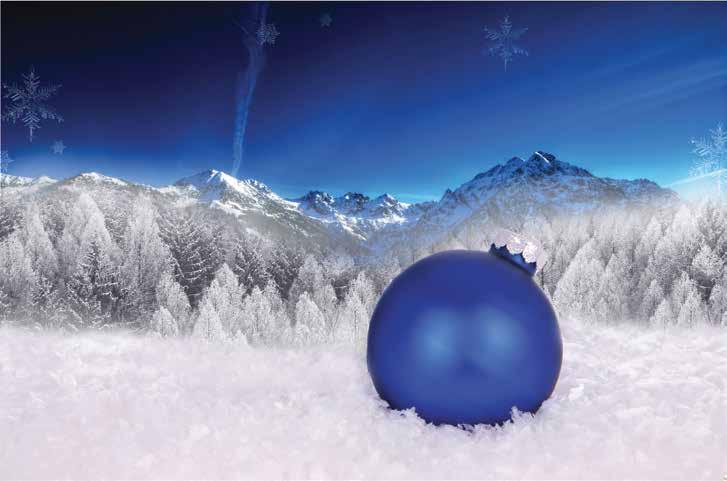

OUR STATE THROUGH THE WORDS OF OUR POETS
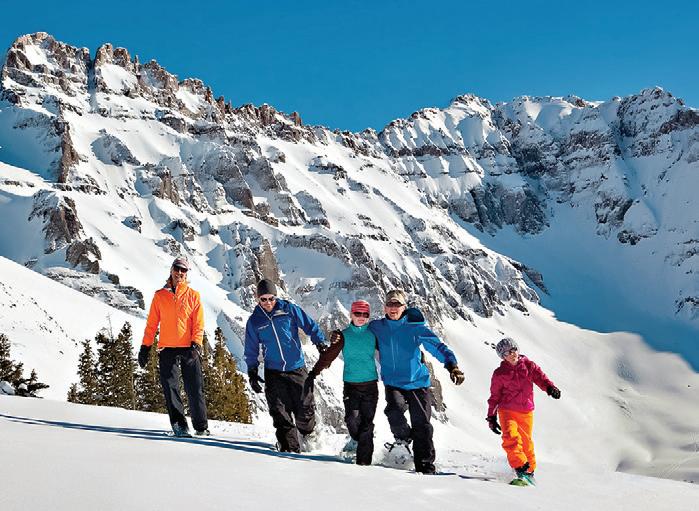
As families come together for the holidays, the conversation often turns to shared memories. In this issue, our poets explore their own Colorado memories of important places and people from their past.
Robert Basinger,
Rifle
He bought a one-way ticket
No return
Will he make it?
A fire burns
Heading for those
Friendly skies
See you later
No goodbyes.
Five hundred dollars in his pocket
Head full of dreams
Of lofty peaks
And mountain streams
So innocent
A bit naïve
Young enough to Still believe.
Spent his whole life
Running free
So many things
He had to see
The great outdoors
Ran through his blood
He came to Colorado And fell in love.
Nancy Cummins Bierman, Littleton
Memory redefines and polishes plain siltstone seen through water reminiscence burnished by a dream
When I was very young it seems we stayed a timeless time in the mountains in a cabin that had a creek nearby
It was a gentle baby stream where two young kids could safely wade I think that’s why it liked to play
My brother and I had a toy canoe
Or maybe it was a piece of bark we found
Over and over we would run upstream to send our tiny bark boat bobbing skipping whirling over stones downstream until it reached a little bridge a boundary that we were not allowed to cross
Over and over tirelessly the stream would carry our canoe for us The way it laughed I thought it must be glad to have a chore glad to find companions as it rippled on its way
Where did it come from? Where was it bound? Did it grow up in a hurry as it hurried on its way?
In my memory it speeds toward a forbidden bridge and vanishes – evaporates like mist
As self-contained as childhood it had
no bigger stream to join no rapids to traverse no ocean to merge into no purpose but to flow into a dream

On previous page, a family enjoys the snow at Telluride. The Milky Way shines above the Sneffels Range.
Hannah Henry, Port Huron, Michigan
I love returning to familiar places
How wonderful!
To remember each turn of this trail, how to step carefully where I have stepped before Which flowers grow here
My old friends
This river remembers me
For I have paused here many times listening to its song and watching light dance upon its surface
Though ever-changing currents alter the topography of underlying sand each year
This lake remains familiar, My home
I love returning to familiar places and being greeted by the memories of all the times I have abided here before
I also love exploring new places I love a good adventure
How exciting – to discover the unknown! But more than the thrill of uncertainty, I love how, imperceptibly, the new becomes Familiar
Not boring, or worn-out but another
Home
Cher L. Tom, Palisade
Like a patchwork quilt stitched with pieces of the past Velvet nights sprinkled with stars above the mesa Are delicately sewn in every corner, Trailing stardust over fourteeners and flat-tops alike.
Tight-laced boots dance up hiking trails
Bike the Palisade Plunge, And skitter to music on the plaza during Peach Fest
Without missing a beat – or a step.
Christmas tree cut-outs edged with white ricrac Center the quilt, drawing memories
Of blue spruce trees and eggnog smells
Warming us on Christmas Eve and beyond.
Snow drifts slide away into Colorado sunshine
When I wrap my patchwork quilt of memories
Around me, until I dance again – smiling.
J. Craig Hill, Grand Junction
That point in the high plains between Kansas and Denver Where clouds on the horizon first morph into mountains
A breakfast of omelets, croissants and Chablis
In a little French restaurant overlooking Lake Dillon
The stone fruits from Somerset, Hotchkiss and Paonia
A trip in the time machine they call Mesa Verde
A night in the San Juans under trillions of stars
DO YOU WRITE poems about Colorado? The next poetry theme is “Potpourri” (open category) for January/February 2023, deadline Nov. 15; the theme is “Sunrise” for March/April 2023, deadline Jan. 15, 2023. Send your poems, including your mailing address, to poetry@coloradolifemag.com or to Colorado Life, PO Box 270130, Fort Collins, CO 80527.


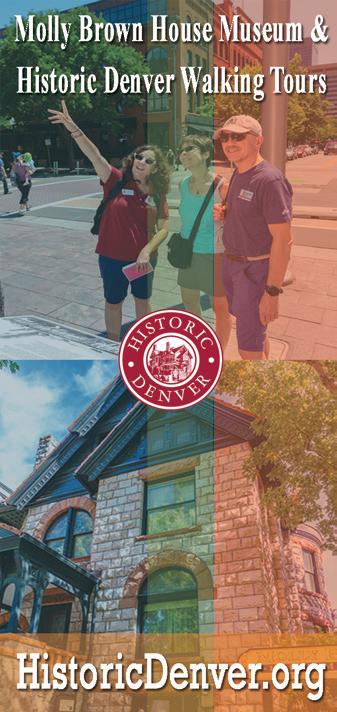




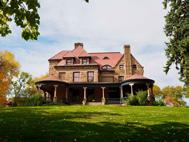



Colorado
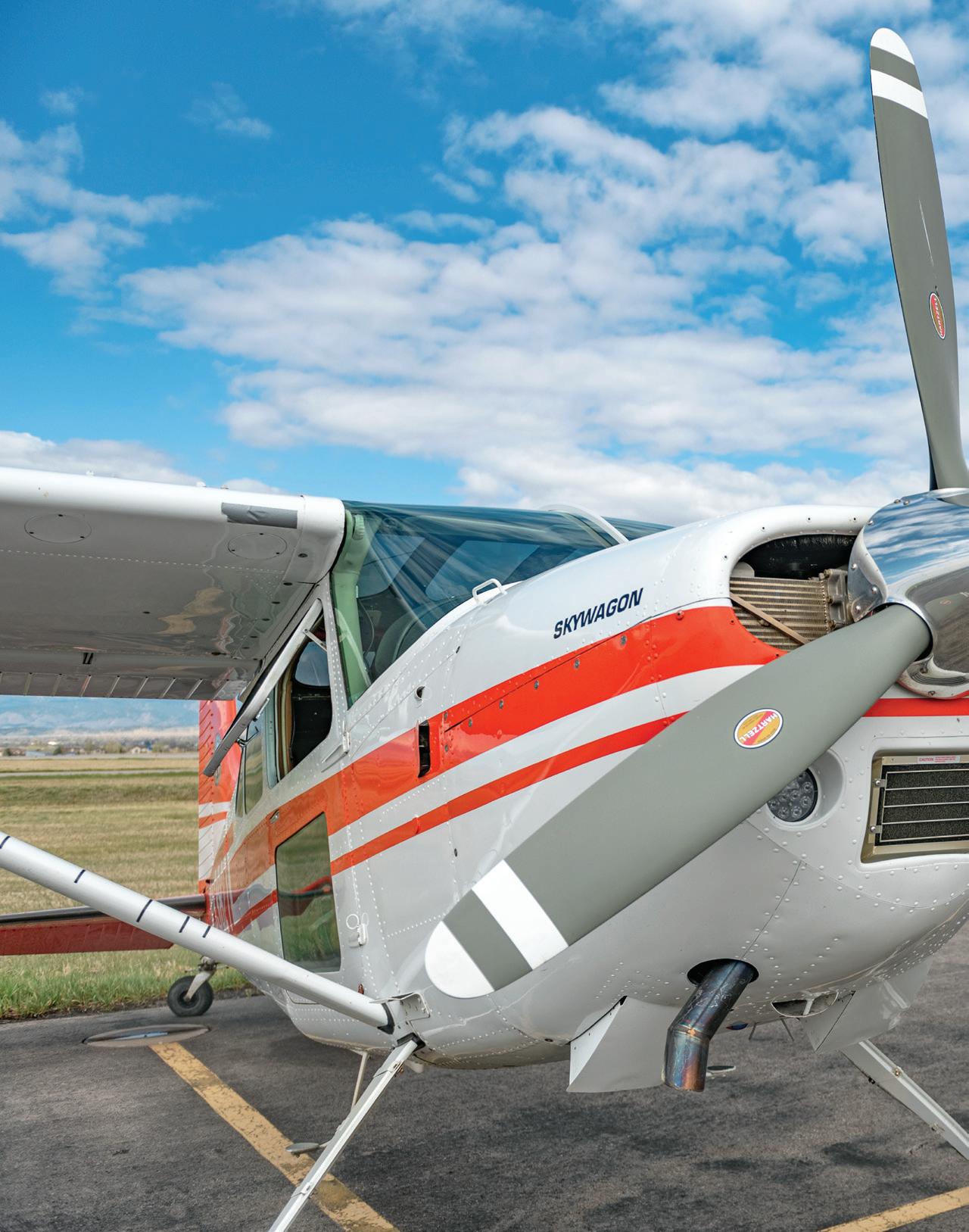
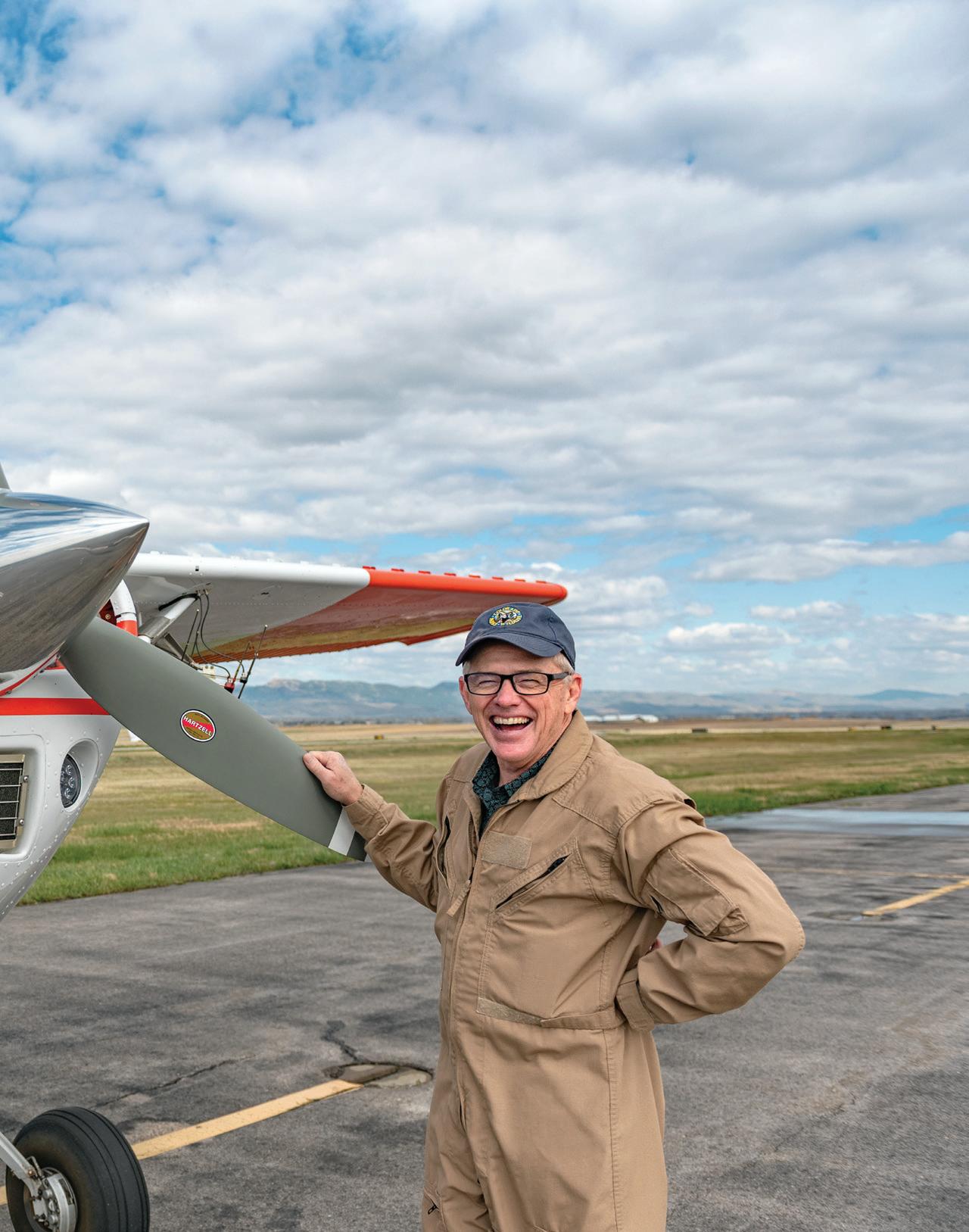
Aerial survey team takes to the sky to keep tabs on Colorado’s wildlife
by CAROLINE ARAIZA
AT SUNRISE ON the Eastern Plains of Colorado, a pilot, a biologist and a local game warden all jump into an airplane. This is not the beginning of a joke but the beginning of one of Colorado Parks and Wildlife’s pronghorn surveys, completed via aerial survey every July and August.
The aircraft is a completely manual Cessna 185 Skywagon taildragger with four seats and an extremely tight cockpit. The pilot, Denise Corcoran, takes off and flies the group extremely low, at around 500 feet, along parallel transect lines 5 to 7 miles apart. The pronghorn have come to recognize the yearly rumble of the Cessna and are up and moving before the plane even reaches their area. Some of the fastest animals on earth, they run up to 60 miles per hour in a straight line, and Corcoran zips along right next to them.
The biologist, Shannon Schaller, is literally rubbing shoulders with Corcoran on the left; she grips a tape recorder and calls out each pronghorn as a doe, buck or young of the year. It takes all three people to call out the animals, making sure not to count any twice, and when the pronghorn begin to lose their shadows as the sun moves overhead, the team calls it a day.
Corcoran is one of four pilots that make up CPW’s statewide aerial survey team, and this yearly pronghorn mission is just one the team undertakes. At its core, the aerial survey division is responsible for understanding animal populations and conducting studies on health and migration patterns.
They track bats to bears and everything in between, and they act as data collectors for the incredible diversity of wildlife in our state. Surveying from the air instead of the ground is less intrusive to wildlife, and it allows for the coverage of a larger geographic area with less human effort and better information in the end.
The team’s work is no safari; pronghorn counts are an extremely methodical three or more hours inside the 100-degree cockpit with no stretch or bathroom breaks to look forward to.
They don’t have to take a census of every single animal – usually, a statistician will tell the team how many miles they need to fly in the area in question and how
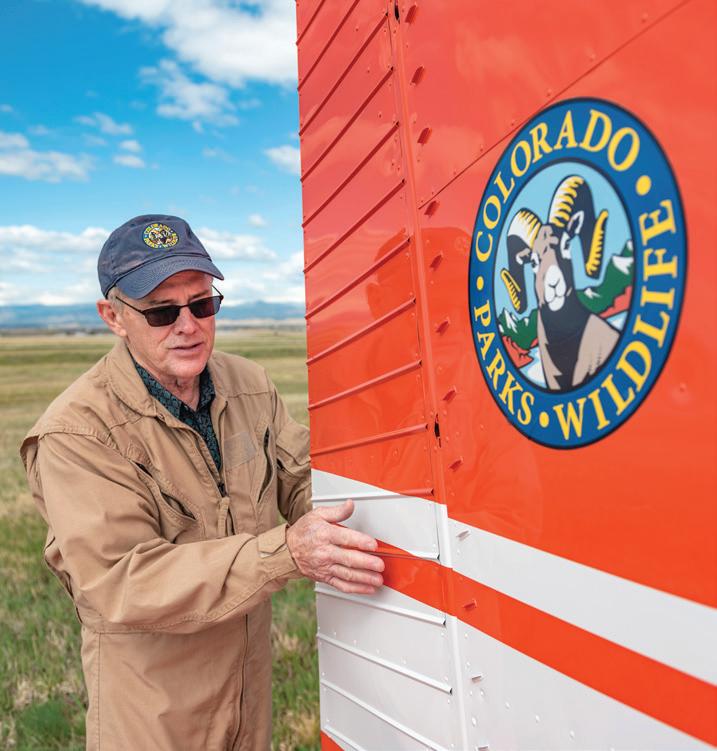

many animals they need to sample in order to make a statistically valid statement about the whole group. When counting pronghorn, the crew is also focusing on ratios: the fawn-to-doe ratio and the buck-to-doe ratio, which CPW then uses to determine how many pronghorn tags to issue hunters.
Programs like CPW’s are usually found in states with big game, since it’s such a huge resource to manage, and are funded mostly by the hunting licenses they dole out. Not every state has its own pilots, but Colorado has four: Denise Corcoran in the southeast quadrant of the state, Larry Gepfert in the northwest, Brian Smith in the northeast, and Steve Waters in the southwest. If Colorado was cut into quadrants, that’s basically how the pilots split the state into regional areas, flying out of Colorado Springs, Grand Junction, Loveland and Montrose, respectively.
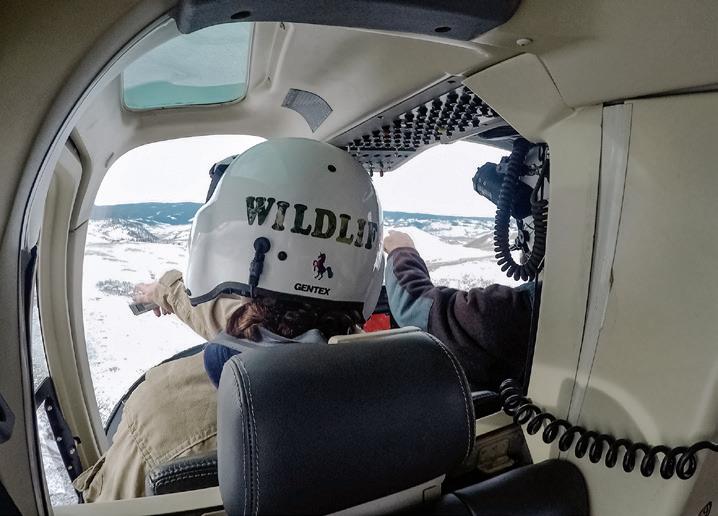
Biologists sit beside the pilots to call out animals they spot during aerial surveys, which help the
populations and migration patterns. Elk are one of

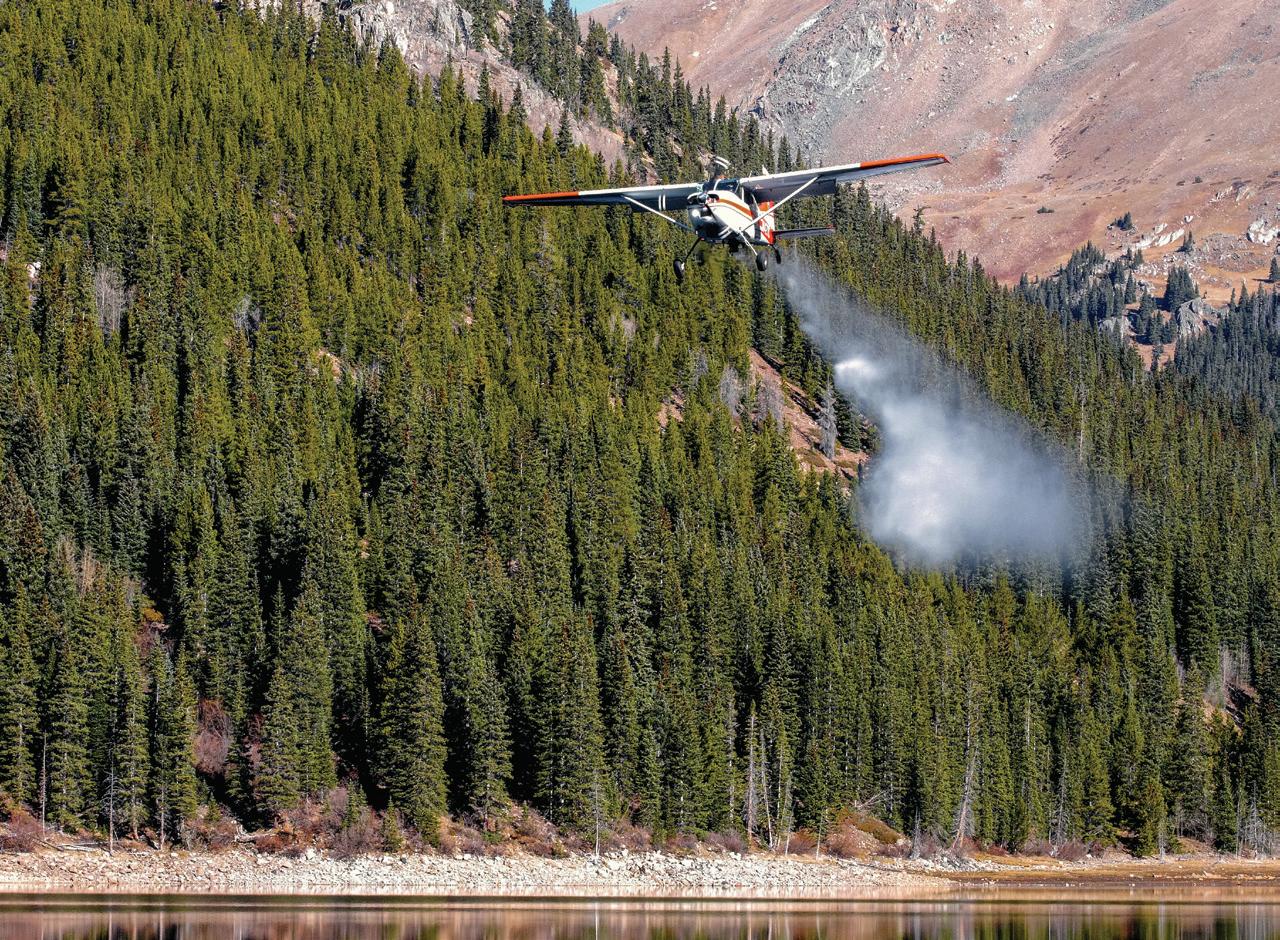
At 39 years old, Corcoran is the youngest, newest and currently only female pilot of the four. She has flown for backcountry lodges in Alaska, a nonprofit in Central America and a humanitarian organization in Africa – all before she competed against 150 other pilots to land this highly coveted job.
SOME OF THE more difficult work the pilots undertake is stocking high alpine lakes with trout in the early fall, which takes incredible mental and physical ability to pull off. The majority of the lakes are above timberline, and the ideal drop-zone for the fish is approximately 150 feet off the water with an airspeed of around 90 mph.
Flying this low and slow in a small plane can be an incredibly dangerous undertaking – the planes are backed right up against
rock faces because the lakes aren’t very big, and if even 15 knots of wind come into the picture, the pilots might have to try another lake and come back later.
To prepare the planes, the seats are taken out so that they can carry nine storage tubes that each hold around 2,000 inchlong trout fingerlings and four gallons of water. In one voyage, a Cessna can stock up to nine different lakes – one lake per tube. Only on their third year of stocking can new pilots actually do it solo, and every detail must be perfect.
“When I was loading up the fish and took off,” Corcoran said, “I was looking around like, ‘Whoa, I’m alone.’ Not many people do this; I think I’m the only female pilot that does high alpine stocking.”
Thanks to the dense water that encases the fish, more than 90 percent of the fin-

gerlings survive the drop. Corcoran opens the chutes with a switch on the airplane panel, and she can see the fish dropping into the lake like rain.
“You can’t hear the fish fall,” she said. “All you can hear is the hopper opening and the roar of the air coming through before you close the flap.”
States like Idaho and Montana use helicopters to do their fish stocking, but because of the distance between lakes in Colorado, Corcoran and her coworkers use fixed-wing airplanes, which can go the distance but can’t hover.
“That’s why we all respect it so much,” Corcoran said. “The plane has come to feel like an extension of myself, and you need that connection at such a low level.”
FLYING EVERY DAY could, in theory, drive one to complacency, but each pilot is exceedingly safety oriented.
“I fly knowing I have these peoples’ lives in my hands; I know their wives and husbands and kids,” northeast pilot Brian Smith said. “If there’s something in the back of my mind that I’m at unrest with, I won’t go. I’ll tell them, ‘I’m not sure what it is, but let’s see about doing it tomorrow.’ ”
As northwest pilot Larry Gepfert put it, they try to use their superior decision-making so they don’t have to use superior skill.
Some of Gepfert’s most treasured times on the job are witnessing early Colorado mornings at 400 feet as opposed to 40,000. He recounts a time a few years ago counting grouse in the spring, flying over little bald knobs of land called leks, where the grouse mingle in mating season like it’s a middle school playground.
“We can fly over at 100 feet, and it doesn’t disturb them,” Gepfert said. “The males have this white patch of feathers on their chest that they blow up. They were strutting around, and they flashed those white feathers into the sun just as it was coming up.”
That morning was a high humidity morning, which is unusual for Colorado, and a few clouds were left sitting on top of a rim, falling over the edge of it like a waterfall.
“We could see those little grouse flashing their feathers at us, kind of like
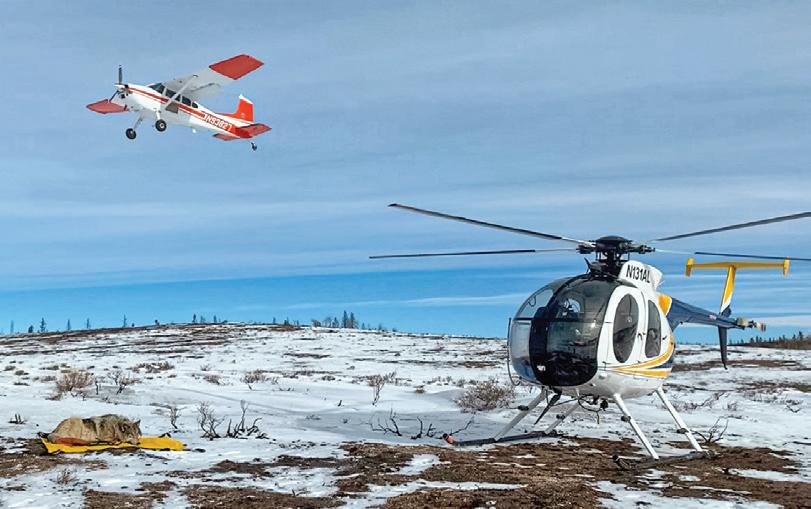
mirrors in the sun, and that waterfall of clouds in the background, and it was absolutely breathtaking,” Gepfert said.
ALTHOUGH CORCORAN, GEPFERT, Smith and Waters work in different areas of the state, they all have somewhat similar tasks depending on the season. Their years usually start out with waterfowl surveys in January and nest surveys later in the spring. Summer means pronghorn flights, followed by early-fall fish stocking, as well as surveys such as black-tailed prairie dogs and lesser prairie chickens.
In the winter, the four pilots help capture and collar elk. This effort involves collaboration between the planes and the contracted helicopter capture crew. The pilot, knowing the area and wind conditions, flies ahead in the plane and spots groups of elk, then relays that information to the helicopter team. To make sure that the animals don’t become exhausted, there are rules for how long they can chase animals from the air.
“I want to be intentional when we interact with animals,” Corcoran said. “We don’t want to upset or endanger them.”
Once an elk is located, it will be netted
from the helicopter, and the biologists will secure the elk’s front legs to its back legs so that it is kept safe without drugs but isn’t able to kick. In less than five minutes, the team can have the elk’s blood drawn and a radio collar affixed to its neck.
Keeping track of elk populations via radio collars helps CPW collect data on herd distribution and demographics, and the location data helps inform herd management strategies and land-use planning decisions. Thanks to the pilots’ highly efficient scouting, this typically week-long project can be diminished to only a few days.
As all pilots agreed, the work is hard, and theirs is a very coveted yet high risk position.
“Flying in Colorado is really challenging,” Corcoran said. “In winters you have jet streams over the mountains, and in the spring and summer, you have wind shears, thunderstorms, hail, microbursts.”
The work can be mentally and physically exhausting, she said.
“I take my work very seriously, and yet I love seeing everything from the big picture perspective,” Corcoran said. “I love to see projects I’ve been working on come into fruition.”

Breckenridge Ski and Snowboard School
Training Manager
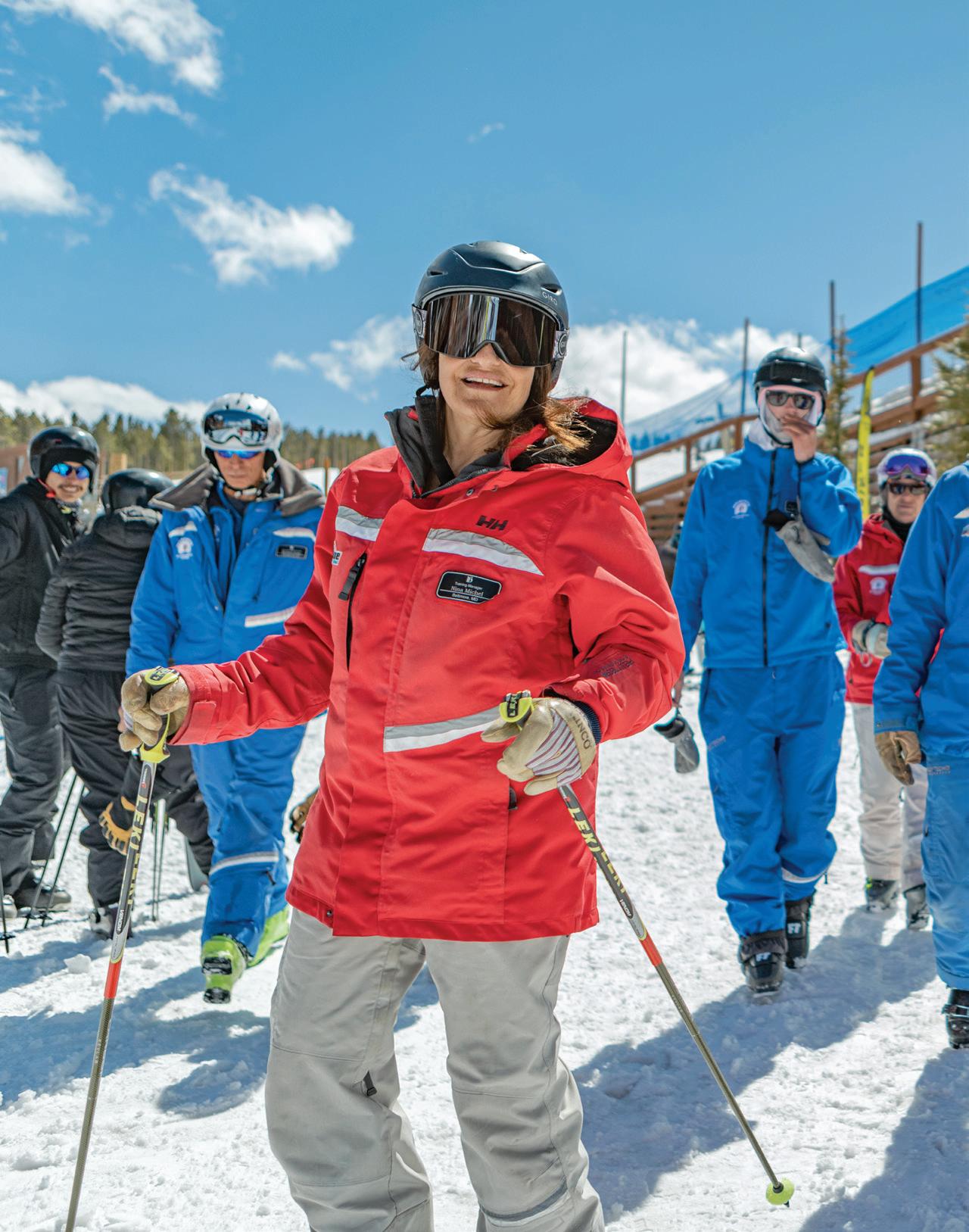

story by MATT MASICH photographs by JOE KUSUMOTO
AS ONE OF the nation’s most-visited ski areas, Breckenridge Ski Resort requires a small army of employees to operate everything that goes on at its five peaks, three base areas and nearly 3,000 acres of skiable terrain. From ski lift maintenance to ski patrol, Colorado Life met seven of Breck’s dedicated crew members to find out what they do to keep the resort running.
ADAM PINO
Lift Maintenance Director
Skiers and snowboarders at Breckenridge move up the mountain using 24 ski lifts, along with 11 smaller carpet and platter lifts. Adam Pino is the man in charge of making sure all these lifts run smoothly and safely all winter long. His 26-person crew inspects each lift at least twice a day, and they climb each of the hundreds of lift towers for monthly checks.
People often ask Pino what he does in the summer, assuming he has plenty of free time. In fact, summer is when much of the hardest work takes place. His crew visits each tower, lifts the cable, changes out and realigns the wheels and greases the machinery.
Installing new lifts is another summertime job. Because cranes can’t easily get up the mountain, the crew often installs the enormous lift towers using helicopters to lower them onto concrete bases. The toughest lift to install was the Imperial SuperChair, which tops out at 12,840 feet. To get the lift terminal to the very top, they had to use a military Chinook helicopter, whose powerful rotor wash blasted the crew on the ground.
“If you didn’t weigh at least 180 pounds, you had to have rocks in your pockets, because you were going to blow away,” Pino said.
When the Chinook first attempted to place the top terminal on its concrete slab, the wind was too high to get it exactly into place, so the helicopter set the terminal down beside the slab. The Chinook came back when the wind calmed down, but when it tried to pick up the terminal, the helicopter couldn’t lift it because the air was so thin at that altitude. Pino’s crew had to break down the terminal into three huge sections to allow the helicopter to pick up and set the individual sections into place. Then his crew had to reassemble it by hand. It was a success, and the Imperial SuperChair is now North America’s highest ski lift.
JOHN ANICITO
Snowmaking Manager
Breckenridge’s snowmaking operation literally lays the foundation for the skiing experience at the resort. The mountain may have a 60-inch base of snow during the season, but the critical first 18 inches are usually manmade.
“Without snowmaking, most ski areas wouldn’t be able to operate the way we intend to,” Breckenridge Snowmaking Manager John Anicito said. Snowmaking gets the resort opened in early November and allows it to stay open into May. Breckenridge has four year-round snowmaking employees and 36 seasonal workers who work 12-hour shifts around the clock.
The manmade snow starts as water in the Blue River, which flows through town. Water is pumped through pipes uphill to hydrants located throughout the mountain. Workers hook hoses from the hydrants to snow guns, either the 30 TechnoAlpin T40 mobile fan guns or the hundreds of permanently installed tower guns that run on compressed air.
Both types spray a mist that freezes in midair into snow. The crew can adjust the spray to make the snow wetter or drier.
The temperature typically has to be 28 degrees wet bulb (combination of air temperature and humidity) or colder to make snow. The test to ensure the snow is the right consistency? Just make a snowball.
“We aim for a packable snowball that can easily be put together but also easily break,” Anicito said. “If it’s too wet, you pack it and water’s dripping out; if it’s too dry, you try to pack it and it dusts up in your hand.”
Grooming Graveyard Shift Team Lead
When the snowmakers make snow, it accumulates in big piles known as “whales.” To spread it out evenly over the mountain requires groomers driving snowcats with a blade in front and a tiller in the back. The groomers also work to undo the impact skiers have on the mountain.
“Skiers bring the snow down the hill and to the side,” snowcat operator Dave Mastrobuono said. “We bring it back up the hill and to the middle.”
Each night, 24 snowcat operators work to groom the mountain – half work the



evening swing shift, half work the graveyard shift. As graveyard shift team lead, Mastrobuono’s workday begins at midnight, when he climbs into the cab of his PistenBully 600 snowcat.
The snowcat cab is spacious and toasty warm. Instead of a steering wheel, there are separate controls for the left and right tracks. The snowcat has a zero turning radius; when one track goes forward and the other goes in reverse, it can pivot in place.
Though the snowcat resembles a bulldozer, it is much lighter. In fact, its aluminum construction means it weighs as much as just the tracks alone on a Caterpillar D9 bulldozer. Its blade differs from a bulldozer’s, too – it is articulated and adjustable to 12 settings, such as curling to the left or right to push snow exactly where it needs to go.
After using the blade to push snow uphill, Mastrobuono uses the tiller to grade the snow into a smooth, even surface with a distinctive corduroy pattern.
Each morning, before any skiers or snowboarders are allowed up the mountain, 40 members of the Breckenridge Ski Patrol fan out across the slopes to make sure the snow is as safe as possible. It is a responsibility Ski Patrol Director Hunter Mortensen doesn’t take lightly.
“We are the stewards of the mountain and all the people who come to experience it,” he said.
A top priority is avalanche mitigation. The goal is to make avalanches happen artificially so they don’t happen when people are skiing. The morning after a snowstorm comes through, patrollers seek out new snow drifts. When they see a drift that wasn’t there the day before, he said, that’s when they know they need to knock it down.
For some avalanche hazards, mitigation is as simple as skiing across the top of a ridgeline to release the snow. But in situ-
ations where that wouldn’t be safe, there’s only one solution: explosives.
“It’s the newer version of the old-school stick of TNT,” Mortensen said. The 3-kilogram explosives look similar to a stick of dynamite and are a little smaller than an average person’s forearm. They are deployed either by hand using a 90-second fuse, or by shooting it out of the avalauncher – a cannon that works like a pneumatic baseball pitching machine.
When guests arrive on the mountain, patrollers keep on the lookout for people who need help. “Whenever the human body is playing with gravity, there are always things that can happen,” Mortensen said. If someone is injured, patrollers are there with a toboggan to ferry them to medical help.
“When somebody gets injured skiing,” he said, “the most rewarding thing is when they come back later and seek you out, thank you and show you how excited they are to be back on the mountain.”
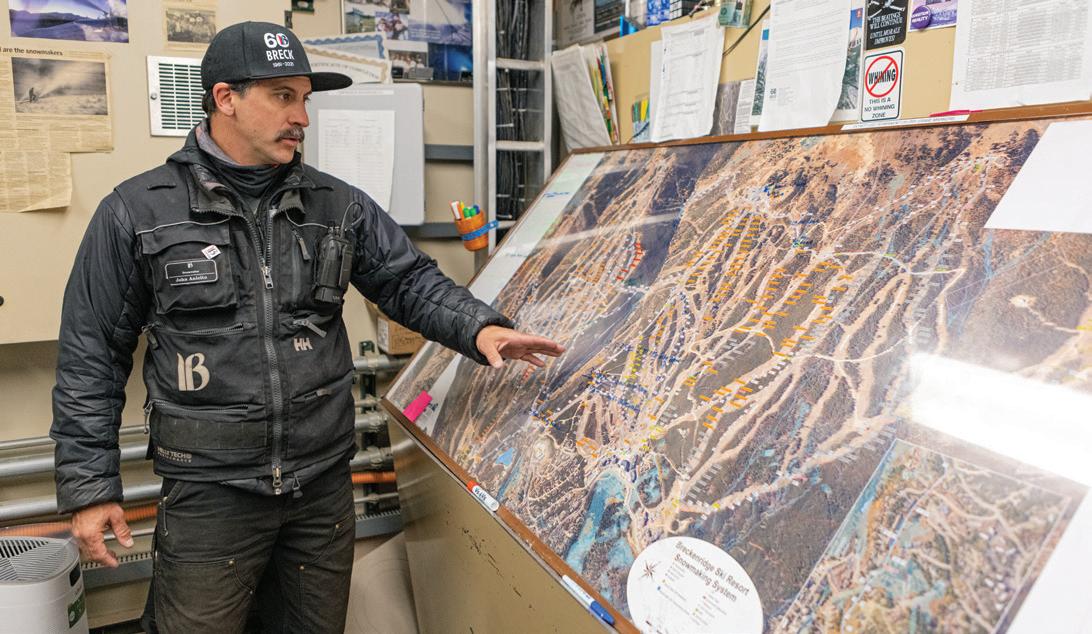
NINA MICHEL Ski and Snowboard School Training Manager
The 700 instructors at the Breckenridge Ski and Snowboard School are a diverse lot. Some are young ski bums, but there are also retired generals, psychologists and Fortune 500 CEOs. Nina Michel oversees the training of all these instructors.
Instead of the three R’s, instructors learn the five T’s: terrain (knowing a run’s difficulty level), tactics (which side of a run to go on), traffic (being aware of other skiers), timing (the time of day affects snow conditions) and task (what exercises the students are doing). But that’s just the bare minimum instructors must know.
“There’s a lot more to teaching skiing than teaching skiing,” Michel said. “In any given lesson, instructors can be anything from a life coach to a marriage counselor.”
Learning to ski or snowboard can be a life-changing experience, she said, and it is fun to watch that happen. One of her favorite students was a boy from Scotland who at 8 years old weighed well over 100 pounds and had never been involved in athletics. He struggled to learn to snowboard, but he kept at it, and by the end of his first day, he exclaimed to his father, “You know, Dad, I’m a snowboarder!” His passion for snowboarding turned him into an athlete, and he is now an All-Scotland pro rugby player.
Michel has a shortlist of suggestions for absolute beginners. First, don’t “over-terrain” – that is, don’t attempt runs above your skill level. Second, spend the money on a professional boot fitter; how well ski boots fit goes a long way in determining your success on the slopes. And finally, “in the interest of marital harmony,” never try to teach your spouse to ski – it’s definitely something best left to the pros.
Ski Patrol Director Hunter Mortensen and ski patrol dog Huckleberry keep an eye out for anyone who might need help on the slopes. Each morning, Mortensen and fellow patrol members fan out across the mountain to make sure the snow is as safe as possible.
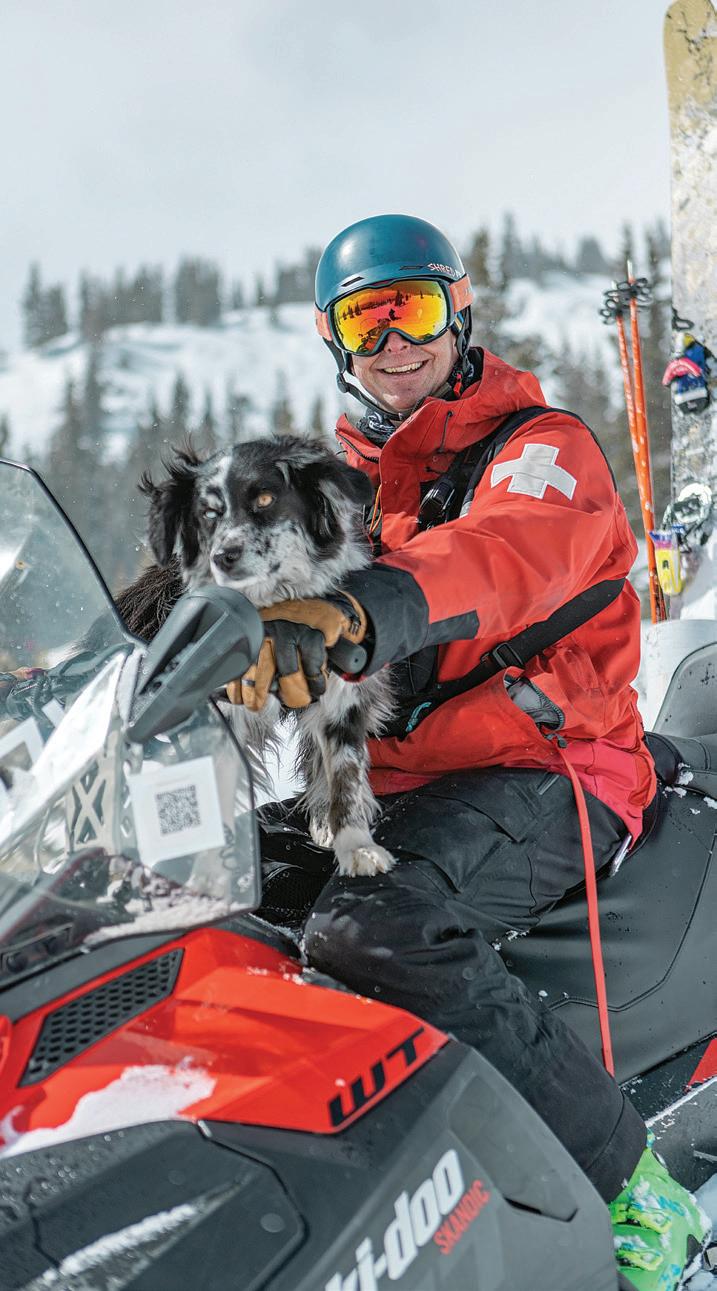
Transportation and Parking Senior Manager
Commuting to work on a ski slope is a lot different from most other workplaces. For the majority of Breckenridge employees, it involves riding one of the buses that are in constant circulation throughout the resort from 5:15 a.m. to 6:30 p.m. Once all the employees are at their stations, the buses deliver skiers to the snow.
As senior manager of transportation and parking, Chelsea Roth is in charge of making sure everyone gets where they need to go. “We play a lot of puzzle games each day, depending on where our set routes are and where our volume is,” Roth said. Breckenridge has employee housing both in town and further afield in Keystone. Shuttles pick up employees at their housing or at designated employee parking lots. Parking is a critical element of the operation, too. After all, she said, “You can’t go skiing without parking first.”



Every day, skiers push snow down and to the sides, so every night, groomers push it back up and to the middle. Transportation Manager Chelsea Roth and Assistant Transportation Manager Kort Langlinais make sure people get where they need to go.
Bus drivers need a commercial driver’s license and passenger license. It takes 14 days of training to get those licenses, then another week of route training before drivers are ready to start at Breckenridge.
What Roth loves about her role is being the first touchpoint for guests and employees. If someone needs to know how to get somewhere or what is open, the drivers are there with answers.
Resort Operations Manager
Breckenridge has four ski-in/ski-out on-mountain restaurants. People dining there are usually too focused on enjoying their meals to spend much time wondering how their food got to the top of a mountain with no road access.
Overseeing the logistics of food and beverage service is Pedro Ramidan, resort operations manager. Ramidan is in charge of the warehouse that stores supplies for the entire resort. As the resort starts clos-
ing down each day, he and his operations team load pallets of food onto two snowcats and head up the mountain to make deliveries. The front of the snowcat has a forklift, and the back has a cage that can fit four full pallets.
The mountain is big and wide. To get to the farthest restaurant from the resort’s warehouse, Pioneer Crossing on Peak 7, takes 25 minutes. After he unloads the food, he loads the snowcat with the restaurant’s trash and recycling. During busy times, he usually makes seven trips each night.
“When you are up there at the restaurants with your crew, you can see the entire city of Breckenridge and the sunset,” Ramidan said. “The trip is worth it just for the view.”
He doesn’t always have the mountain to himself afterhours. Because the resort is in a national forest, hikers are allowed uphill access outside of operating hours. And he loves it when he encounters moose. “I’m 6-foot-4, and these moose tower over me,” he said. And a particular favorite of his
is the fox that lives near the warehouse. The first time he saw it, he was delighted – originally from Brazil, Ramidan had never seen a fox in real life before. “I had only ever seen foxes in cartoons,” he said. “I thought it was going to stand up and start talking.”


Each year, from the Saturday after Thanksgiving through New Year’s Day, the hillsides surrounding Cripple Creek and Victor are ablaze with light. Festive ornaments, including some up to 20 feet tall, are wired to the headframes of old mine shafts. Though located on private land, the locally made, large lighted ornaments can all be seen by car.
“It’s like an Easter egg hunt on a larger scale, where you drive around and try to find them,” said Ruth Zalewski, president of Southern Teller County Focus Group, which organizes the annual event in partnership with the Newmont Cripple Creek & Victor gold mine.
Headframes are held over from the Gold Rush days and also known by the sinister
sounding “gallows frame.” The event brings attention to the area’s history; since the 1890s, Teller County has seen nearly 2,000 mining claims.
The Holiday Headframe Lighting tradition was begun by Shawn Tomlinson, who works for the Cripple Creek & Victor Gold Mine, with the event becoming official in 1998. Tomlinson still volunteers more than 120 hours per season to the Holiday Headframe Lighting and replaces every burnedout bulb.
People can take their cars on a self-guided tour of the Holiday Headframe Lighting displays on weekend nights through Christmas and nightly, weather permitting, from Dec. 24-Jan. 1. Maps are online at stcfg.com.
Colorful light displays adorn the headframes of old mine shafts on a tour of a historic mining district.

Baking is a science, but baking at altitude? That’s an artform. At Gold Camp Bakery, all items are produced in-house at nearly 10,000 feet. Owned by a husband-and-wife duo who hail originally from Germany, the assortment of sweet treats, pasties, pot pies and pastries combine the best of German and American baked goods. Don’t miss the biscuits and gravy. 112 South Third St. (719) 689-9300.

GOLD CAMP CHRISTMAS Plan to visit the Holiday Headframe Lighting the weekend of Dec. 9 and 10, and you’ll also get to enjoy the old-fashioned Gold Camp Christmas events. Victor Decorates Downtown and Parade is held in Victor on Dec. 9, and both the Christmas Craft Fair and the Gold Camp Christmas Parade are held Dec. 10 in Cripple Creek. Victor Avenue, Victor; Bennett Avenue, Cripple Creek.

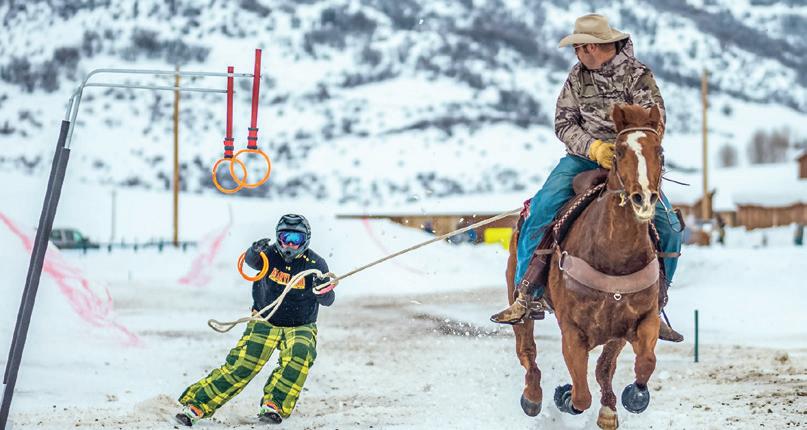
Imagine water skiing, but on snow with a horse, and you have some idea of skijoring. At the Meeker Skijor Races, a skier is pulled behind horse and rider in a two-person, three-creature team, racing to complete a snowy course.
Two days of racing also include a Calcutta auction, where bettors “purchase” teams in hopes of earning cash payouts. The top performing teams win prizes, while fun awards are given for “Best Crash” and “Best Outfit.” Meeker Skijor aims to be as family friendly as possible while still hosting a competitive skijor that attracts racers and spectators alike.
Since northwestern Colorado has a robust population of both equestrians and outdoor enthusiasts, skijoring is a natural way to merge the horse and skiing communities, said Alex Plumb, secretary of the Meeker Skijor board of directors.
Previous races took place in February. When this year’s original scheduled time came without snow, organizers moved it to the final weekend of 2022. Now they can claim to be both the last and first skijor of the year.
Races also moved to Ute Park, a natural auditorium backed by the Flat Tops mountains. Horses and skiers set up just below a breathtaking backdrop, with a tapestry of white ground against a reddish mountain jutting out into the brilliant blue sky. meekerskijor.com.

A local favorite, the casual Mexican House offers up just what it sounds like: Mexican fare in a casual atmosphere. Old branding irons and other ranch memorabilia decorate the wooden paneled walls. Dishes with generous portions constantly come out of the kitchen, and breakfast is served all day. 624 Market St. (970) 878-5535.

Established in 1896, the Meeker Hotel & Cafe has seen its share of history. Its bricks were trucked in by freight wagon from Rifle. After being elected vice president, Theodore Roosevelt stayed while on a hunting trip. A room used by another Roosevelt, Eleanor, now bears her name, and the Gary Cooper Suite is where the actor once stayed. 560 Main St. (970) 878-5255.

Several blocks of Meeker’s downtown are included in a historic district listed on the National Register of Historic Places. Downtown includes a variety of retail, from clothing stores to home decor and furniture. The White River Museum is located in a former military barracks and one of several log buildings downtown that date back to the 1880s. First to Eighth Streets, and Park Avenue, Main and Market streets.
Boulder Jewish Film Festival
Nov. 3-13 • Boulder
More than 20 films and shorts return to the Dairy Center during the 10th anniversary festival. The opening night film is the Colorado debut of Hallelujah: Leonard Cohen, a 115-minute ode to the golden-voiced singer-songwriter and poet told through his most famous song, a prayer set to music. (303) 998-1900.
Nov. 17 • Silverthorne
Cultures from across the globe unite at this celebration as showcased by members of Summit County’s international community. Neighbors learn from and meet new neighbors while sampling food, traditions, music, language and dance at the Silverthorne Pavilion. (970) 262-7300.
Creative Colorado
Tablesetting/Tablescaping
Nov. 19-20 • Estes Park
This fundraiser for the Estes Park Museum awards a blue ribbon to the team with the most creative table settings that reflect this year’s theme: Celebrations, Then and Now. Think past napkins and silverware to decorative gourds, ice sculpture, twinkle lights and anything else you can imagine on the jazziest table. (970) 577-0186.
Nov. 19 - Jan. 1 • Durango
A chuffing steam train whisks children off on a magical ride to the North Pole to meet Santa Claus. The historic Durango & Silverton Narrow Gauge Railroad makes itself over to resemble the beloved Polar Express book and film, serving young riders hot chocolate and creating indelible holiday memories. (970) 247-2733.
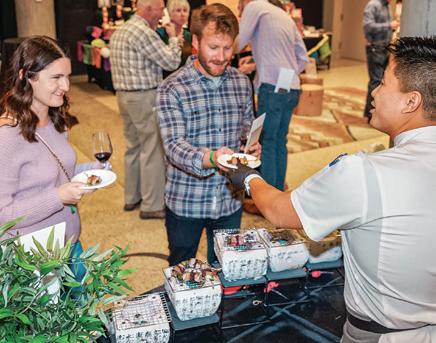
Chefs create food pairings for the 12 best wines from Colorado.
When Colorado wineries and chefs take over the History Colorado Center’s lobby and atrium, it’s a true celebration of wine and food from across the state.
Colorado Uncorked offers a chance to taste the 12 Colorado wines in the 2022 Governor’s Cup Collection alongside food pairings created specifically for those award winners. Wine experts tasted 247 wines from 38 Colorado wineries to select this year’s special collection.
Viniculture likely began in Colorado in the late 1800s, including production in the Grand Valley and immigrants who brought grapes with them for home winemaking. Wine grapes grew all over the state until Colorado passed Prohibition
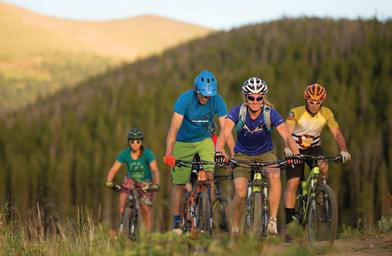
four years early, in 1916.
Though Colorado’s first post-Prohibition commercial winery was established in 1968 using grapes from California, up to 90 percent of wines made here today are made from Colorado grapes. “We actually have more wineries up and down the Front Range than on the Western Slope, though most of the grapes are grown there,” said Doug Caskey, executive director of the Colorado Wine Industry Development Board.
The event has many styles of wine: sparkling, dry and sweet whites and reds, plus a mead. VIP ticket holders enter early and taste “library wines” of award winners from past years. coloradowine.com

You get more at YMCA of the Rockies. More fun familyfriendly activities, wildlife, and miles of colorful Colorado trails for any size family and all budgets!
Don’t let life just happen — make it happen at YMCA of the Rockies!
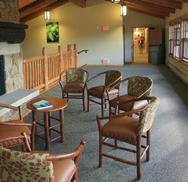
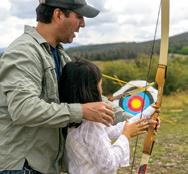
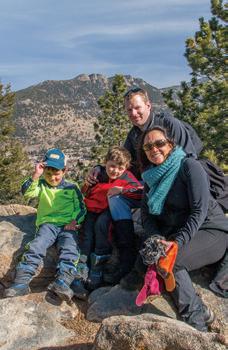
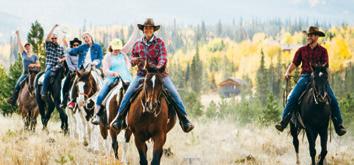


Luxury hotel the ART boasts 165 rooms and its own museum-worthy art collection. Part hotel, part gallery, travelers are greeted by a light installation of 20,000 twinkling LEDs and a lobby curated by the Denver Art Museum. It’s also conveniently located across the street from the History Colorado Center. 1201 Broadway. (303) 572-8000.

A not-so-hidden gem thanks to its recent relocation to Denver’s Golden Triangle neighborhood, Kirkland Museum of Fine & Decorative Art holds more than 30,000 objects that help tell the story of art and design. Current exhibition Frank Lloyd Wright Inside the Walls uses items from Wright’s projects to showcase his range across arts and crafts, art deco and modern styles. 1201 Bannock St. (303) 832-8576.


A Fairy Tale Christmas Carol Dec. 2-18 • Telluride
Steel City Theatre Co. puts on this charming musical inspired by Charles Dickens’ holiday classic. The miserly Ebenezer Scrooge learns valuable life lessons from a cast of characters borrowed from fairytales and other beloved children’s stories, such as the Big Bad Wolf, Cinderella and the Queen of Hearts. (719) 994-8298.
Telluride Fire Festival
Dec. 2-4 • Telluride
Art cars, sculptures that breathe flames, fire eaters, welding workshops, twirling dancers – all are on display at this three-day festival celebrating all things fire. Managed by the nonprofit Rocky Mountain Arts, funds from the festival support sculptural and performing arts all year long. (970) 708-1059.
Ullr Fest
Dec. 8-11 • Breckenridge
Need an excuse to don a Viking helmet and pray to the Norse god of snow for a wet winter and good ski season? The 59th annual Ullr Fest is a reason to parade – and to party, given the annual attempts to break the unofficial world record for the longest Shotski. (970) 453-2913.
Amahl and the Night Visitors
Dec. 11, 13-14, 16-18
Colorado Springs, Boulder, Denver
This family-friendly opera tells the story of shepherd boy Amahl, whose stories are always larger than life. Imagine his surprise when three travelers seek rest with Amahl and his mother in their tiny home and tell the tale of a miraculous child they are journeying to find. (303) 292-6700.
SATURDAY, DEC. 3 • 3 - 6:30 PM
FUN FAMILY ACTIVITIES
Free hot chocolate, cider and cookies
Strolling carolers • Live holiday music
Horse drawn carriage rides
Arts & crafts activities • Artisan Holiday Market








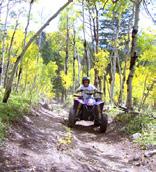






open page




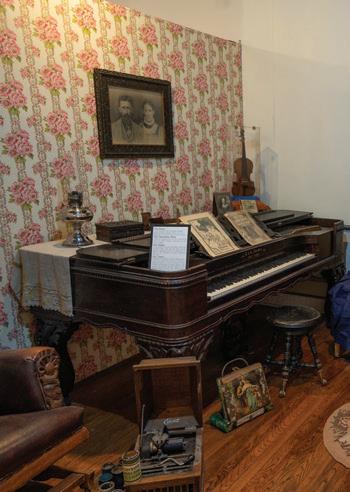

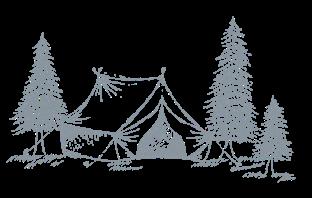
LAUNCHING POINTS FOR OUTDOOR EXPLORATION


by DAN LEETH
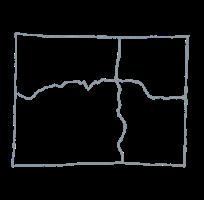
LOCATION
Grand Junction
TENT RV/SITES
Both ACTIVITIES
Hiking, biking, horseback riding, OHV driving
High-clearance roads lead to canyon country campgrounds on the far edge of Colorado’s Western Slope
AS FORMER BEATLE Ringo Starr once pointed out, good things sometimes “don’t come easy.” Such is the case for those of us wanting to explore the wide-open spaces of Colorado’s Rabbit Valley.
This 25-square-mile, canyon-country enclave in far western Colorado lies off Interstate 70, just 2 miles short of the Utah border. Part of the McInnis Canyons National Conservation Area, this broad, multiple-use preserve offers an array of recreational opportunities for hikers, mountain bikers, horseback riders and
OHV (off-highway vehicle) drivers. And, of course, there’s camping.
Until recently, visitors to Rabbit Valley could pitch camp pretty much anywhere they wanted. As the area’s popularity increased, the environment suffered. The Bureau of Land Management now limits overnight use to three designated camping areas south of the interstate. Fifteen satellite sites suitable for travel trailers or motorhomes lie scattered along a graded gravel road that parallels the interstate. Each features a picnic table and campfire ring. There are no water spigots, trash dumpsters or restrooms.
The other two campgrounds, recently modernized by the BLM, require traveling down often rutted, high-clearance dirt roads. The Jouflas Campground sits about 1½ miles from the interstate exit. The first part of the drive comes atop graded gravel with high clearance sometimes needed to
cover only the last half mile of roadway. The campground features 14 sites with picnic tables, campfire rings and wood-bordered tent pads. Several pit toilets stud the area. Squatty cliffs and boulder-clad hillsides border one side of the campground with rolling grasslands and distant cliffs stretching endlessly from the other.
While the Jouflas Campground offers wide-open views and close-in convenience, I prefer the Knowles Canyon Overlook Campground. It lies another 4 miles away down a narrow, often badly rutted dirt road capable of muck-miring even a 4x4 vehicle after heavy rain or snowfall. With low-clearance vehicles and those over 30 feet in length banned from the roadway, this campground is ideal for tent toters and pickup bed campers.
It sits atop the bluffs of Ruby Canyon with the cottonwood-tongued mouth of Knowles Canyon gaping from the cliffs across the Colorado River. Sites along the rim offer views of rafters and kayakers floating slowly downstream. Union Pacific tracks parallel the river, offering glimpses of trains tracking down the canyon. The campground’s 19 well-spaced sites feature picnic tables, fire rings, tent pads.
For those of us who want to do more
than sit back and watch river runners float by, there are a plethora of activity options. Designated routes for all-terrain vehicles crisscross the landscape. Mountain bike trails include the Kokopelli, a 150-mile route from Loma, Colorado, to Moab, Utah. Horseback riders have the Jouflas Horse Trail, named for the same ranching family as the campground, and there are several hiking trails open exclusively to those of us willing to explore on foot.
A favorite hiker-only trail is the Rabbit’s Ear Mesa Loop, whose trailhead lies about a 5-mile drive down the frontage road from the highway exit. A steady slog upward leads to the top of the mesa, offering lofty views of the Colorado River looping through Horsethief Canyon, an area once used to pasture stolen steeds. Stories tell how a local undersheriff once apprehended a band of rustlers down there.
“Have met Brock Gang,” the lawman sent in a message back to town. “Send five cheap coffins.”
Another favorite is the McDonald Creek Trail, whose trailhead lies about 2 miles from the Knowles Canyon Overlook Campground. This out-and-back hike follows a wide, cliff-bound canyon 3 miles to the river. Centuries-old Fremont
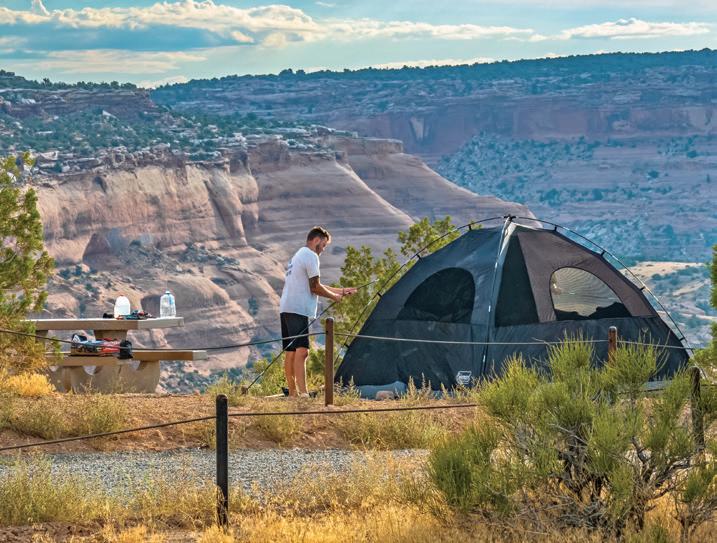
Indian pictographs still decorate rock walls in some of the streamside alcoves.
Until recently, Rabbit Valley camping came free of charge, but that will be changing soon. Starting next spring, a $20 per night camping fee will be assessed, a reservation system (877-444-6777, www. recreation.gov) will be initiated, and BLM may have hosts stationed at the campgrounds. I hope that along with those changes, they also improve the roads. With all due respect to Ringo, I’d prefer that access to Rabbit Valley’s campgrounds came just a bit more easily.
To get to the Jouflas and Knowles Canyon Overlook campgrounds in Rabbit Valley, campers must traverse rutted high-clearance roads.
Rabbit Valley campgrounds can be accessed from Exit 2 off Interstate 70. The turnoff for RV campsites lies across from the off-road vehicle staging area, about a half mile south of Exit 2. The road to the Jouflas and Knowles Canyon Overlook Campgrounds continues due south from the staging area. The campgrounds do not have water spigots nor trash dumpsters. All campsites have a seven-night camping limit.

Questions on p 18-19
1 Quebec City
2 David Thompson
3 Fifth down
4 Mikaela Shiffrin
5 Atlanta
6 a. San Francisco 49ers
7 c. Windsor
8 c. Rocky Mountain Vibes (Yet that became the team’s name.)
9 b. Derrick White
11 False. (The numbers are right, but Michigan schools have a combined 19.)
12 True.
13 True.
14 False. (We didn’t win any!)
10 a. Frank Tripucka (18 was retired for Tripucka, who later allowed Peyton Manning to wear it.)
15 True.
Trivia Photographs Page 18 Coors Field hosted two All-Star Games. In 1978, David Thompson finished third in MVP voting. Page 19 DU wins its ninth hockey championship in 2022.

PHOTOGRAPH
BY
KARLA BOOTH
a frosty 12 degrees below zero, a single snowflake alights on a pine branch in Grand Lake. The six-sided crystalline structure is called a fernlike stellar dendrite – one of the lightest types of snowflake.
Photographer Karla Booth has elevated snowflake photography to a highly specialized artform. It is extremely challenging to corral a snowflake, set it on a background and keep still enough to zoom in tightly without shaking the camera. Classic-looking snowflakes don’t always form when it snows – often, it takes the form of pellets. The driest snow, or “champagne powder,” usually yields the best specimens.
Booth has a “catch board” that she uses to gather snow. She then uses a tiny brush to lift individual flakes onto a preselected backdrop. The macro lens she uses is 15 inches long. Even with the camera on a tripod, she must hold her breath when pushing the shutter button to keep the camera from moving and blurring the image. For all the trouble it takes to photograph a snowflake, the magical results are worth it.

IN EACH ISSUE, Top Take features a reader’s photograph of Colorado. Submit your best photos for the chance to be published in Colorado Life. Send images with detailed photo descriptions and your contact information to photos@coloradolifemag. com or visit coloradolifemag.com/contribute.
This photo was taken with a Canon EOS 50D camera equipped with a Canon MP-E65 f/2.8 1-5x Macro lens at 65mm, exposed at ISO 3200, f/13 for 1/60 of a second.
